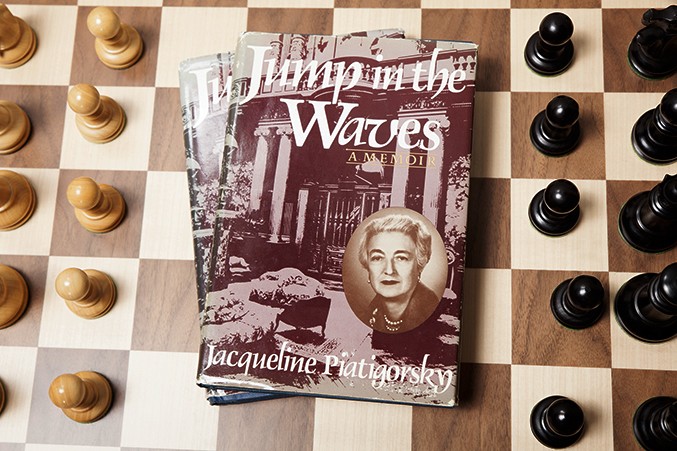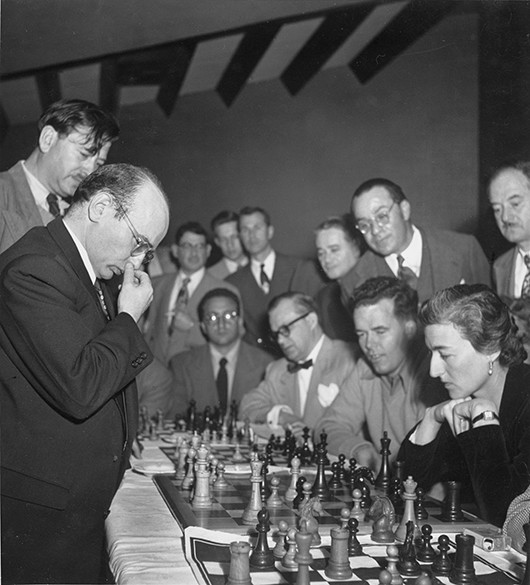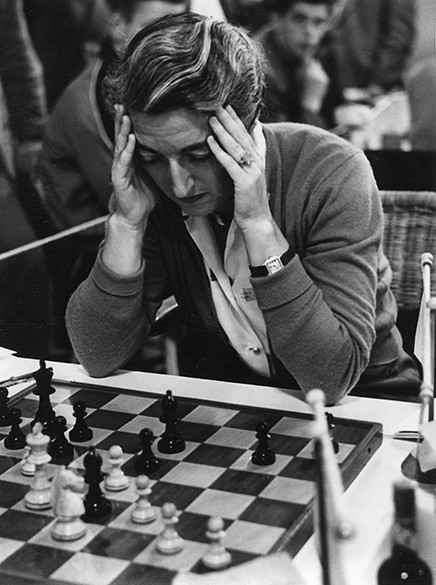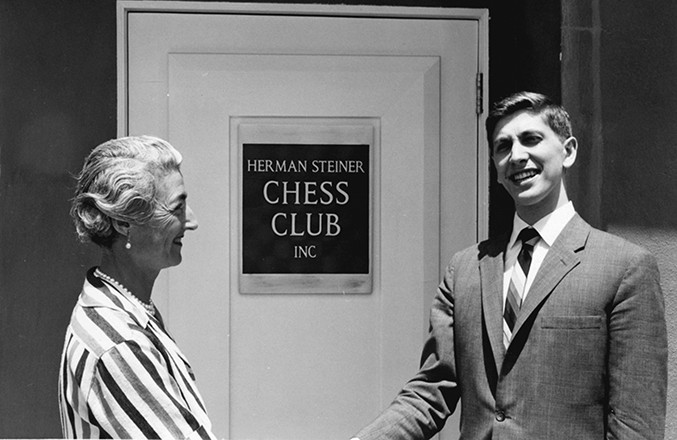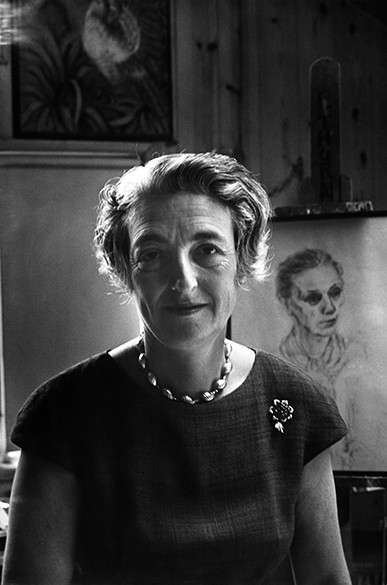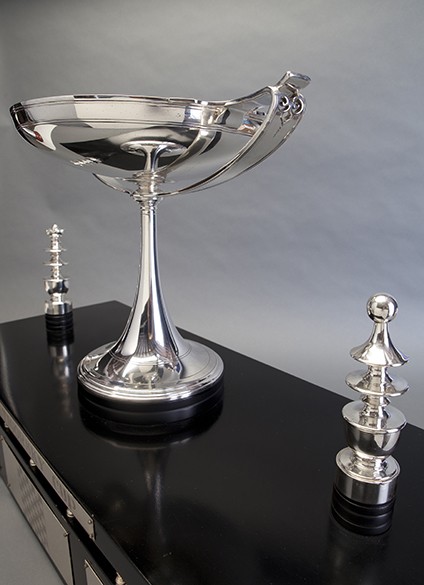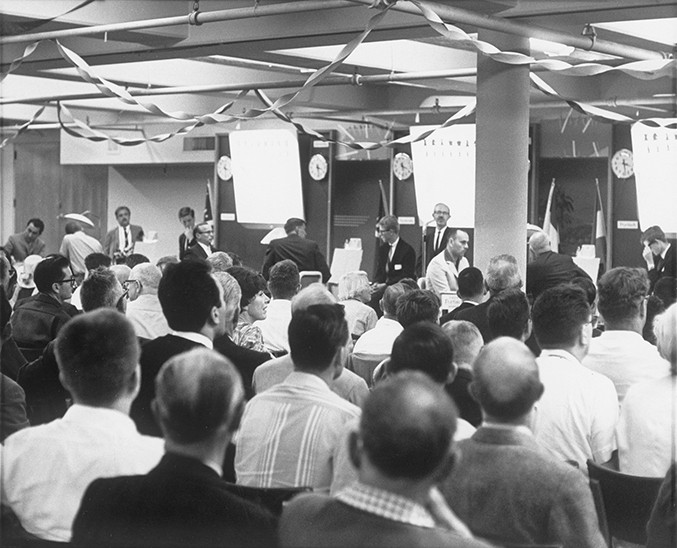Artifacts Featured in the Exhibition
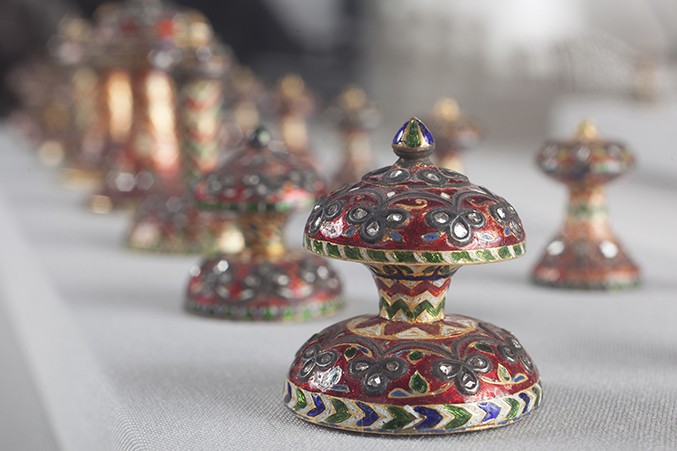
Faux-gem Encrusted Cloisonné Enamel “Muslim Pattern” Chess Set
Early to mid 20th Century
Enamel, metal, and glass
Collection of the Family of Jacqueline Piatigorsky
Photo © Michael DeFilippo
Though best known as a cellist, Jacqueline’s husband Gregor also earned attention for the beautiful collection of chess sets that he displayed at the Piatigorskys’ Los Angeles, California, home. The collection featured gorgeous sets from many of the locations where he traveled while performing as a musician.
This beautiful set from the Piatigorskys’ collection features cloisonné decoration. Cloisonné is a technique of decorating metalwork in which metal bands are shaped into compartments which are then filled with enamel, and decorated with gems or glass. These green and red pieces are adorned with geometric and floral motifs.
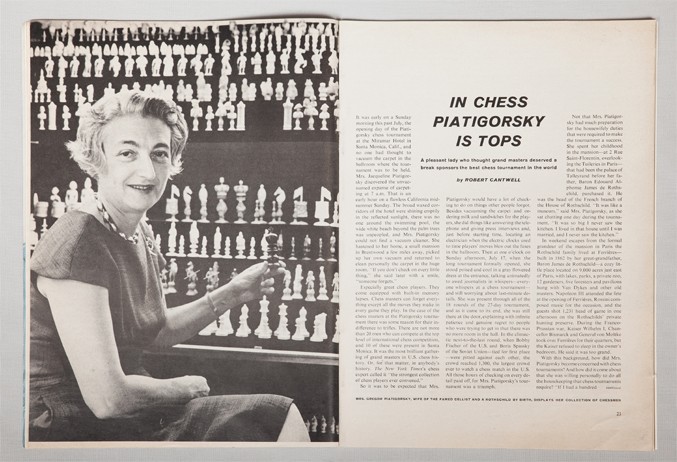
Robert Cantwell
“In Chess Piatigorsky Is Tops.”
Sports Illustrated Vol. 25, No. 10, September 5, 1966
Magazine
Photo © Michael DeFilippo
Published after the 1966 Piatigorsky Cup, this article celebrates the immense organizational efforts undertaken by Jacqueline Piatigorsky in supporting the competition and American chess. Robert Cantwell, the author of the piece, also details her lifelong passion for chess, which began with her learning the game from a nurse during her childhood. In the photograph accompanying the story, Jacqueline poses with the chess set collection that her husband Gregor Piatigorsky, a famous cellist, formed during his travels.
Introduction for Los Angeles Times 1966 Woman of the Year Award
December 20, 1966
Manuscript
For her efforts in organizing the 1966 Piatigorsky Cup, one of the strongest chess tournaments ever held on American soil, the Los Angeles Times awarded Jacqueline Piatigorsky their “Woman of the Year” award. This manscript records the speech celebrating her achievements on behalf of American chess. Jacqueline’s attention to detail was legendary. She not only organized the tournament, but she also ensured that the playing hall was in immaculate condition for the competition and designed a special projector system that allowed audience members to follow the games from a distance.
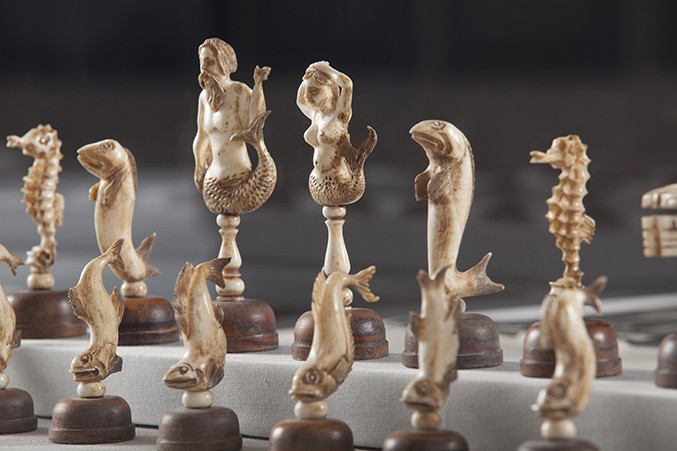
Italian Carved Ivory and Hardwood “Sea Life” Chess Set
19th Century
Italy
Ivory, hardwood, and leather
Collection of the Family of Jacqueline Piatigorsky
Photo © Michael DeFilippo
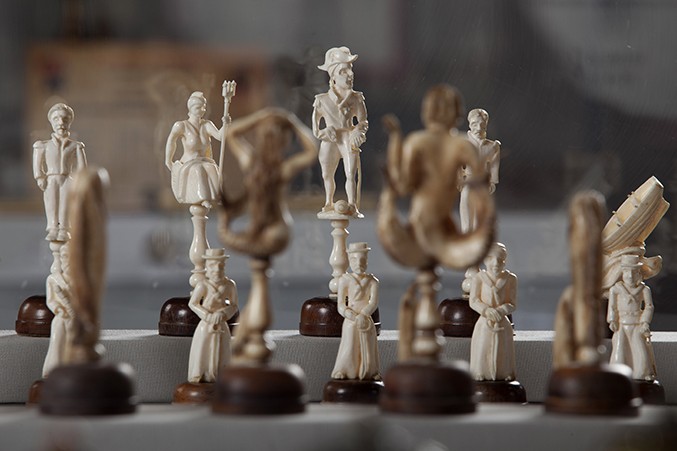
Italian Carved Ivory and Hardwood “Sea Life” Chess Set
19th century
Italy
Ivory, hardwood, and leather
Collection of the Family of Jacqueline Piatigorsky
Photo © Michael DeFilippo
This whimsical chess set from the collection of Jacqueline and Gregor Piatigorsky pits mythical creatures of the sea, followed by a retinue of fish, against the crew of a ship. Waves crash around the base of the lighthouse and a ship struggles to stay upright in the choppy sea—two features that convey the intensity of their battle. Sets like this were works of art meant for display rather than use in play. The Sports Illustrated spread shows the Piatigorskys’ chess set display in their home.
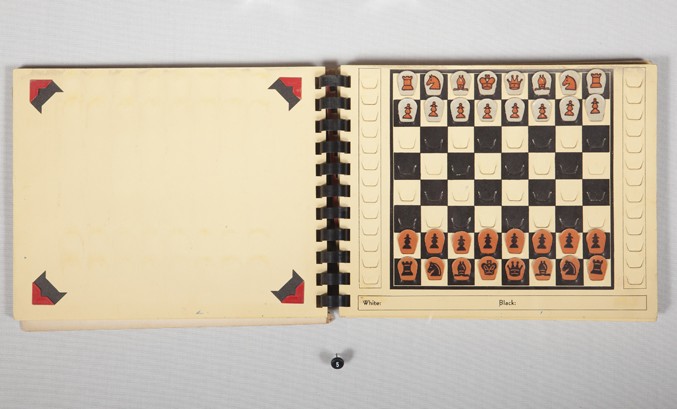
Postal Chess Recorder Album, c. 1940s
Pamphlet
Collection of the World Chess Hall of Fame
Photo © Michael DeFilippo
Jacqueline Piatigorsky was born in Paris to the famous Rothschild family, but immigrated to the United States in 1939 due to the encroachment of Nazi forces on France. She and her family settled in Elizabethtown, New York. There she took up playing in correspondence chess tournaments as a means of dealing with the isolation of her new home. She used this postal chess recorder, which has space for six different games, to record the progress of her contests.
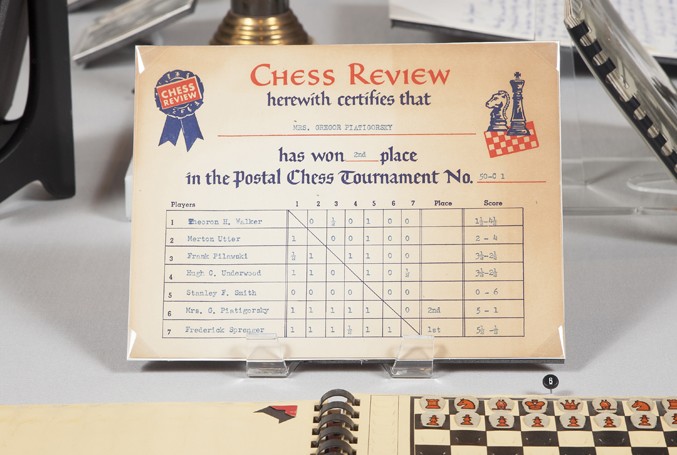
Chess Review Award
Certificate
Collection of the World Chess Hall of Fame
Photo © Michael DeFilippo
Jacqueline found success in her early correspondence tournaments. Largely a self-taught player, participating in chess by mail allowed her to study positions in great depth. In her 1988 memoir, Jump in the Waves, she wrote of fastidiously analyzing her games, going “over each variation again and again.” She was awarded this certificate by Chess Review, a magazine that sponsored correspondence tournaments, for her second-place finish in a competition.
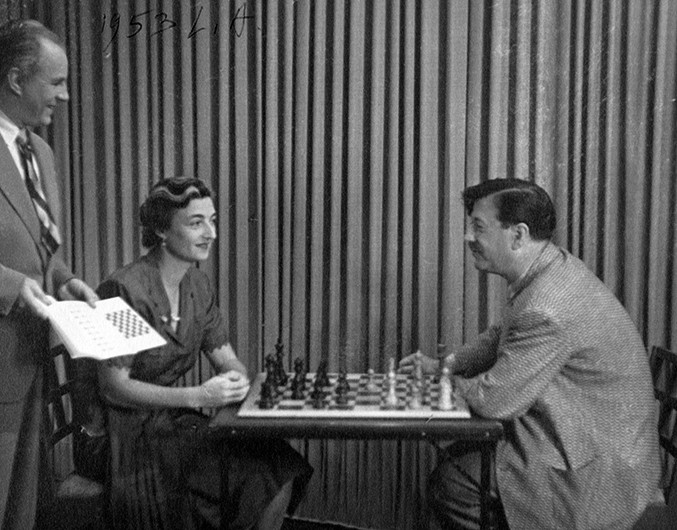
Photographer unknown
Jacqueline Piatigorsky and Herman Steiner during a Television Appearance, 1953
Photograph
Collection of the World Chess Hall of Fame
Herman Steiner, a 2010 inductee to the U.S. Chess Hall of Fame, pictured on the right, was Jacqueline’s dear friend and coach. The two met at an auction in California in 1951. That same evening, Steiner encouraged her to participate in her first competition over-the-board at his club, the Hollywood Chess Group. With his support, Jacqueline soon improved her skill, becoming one of the top female players in America. Here the two appear together on a television show called Cavalcade of Books, which aired on a Los Angeles area station.
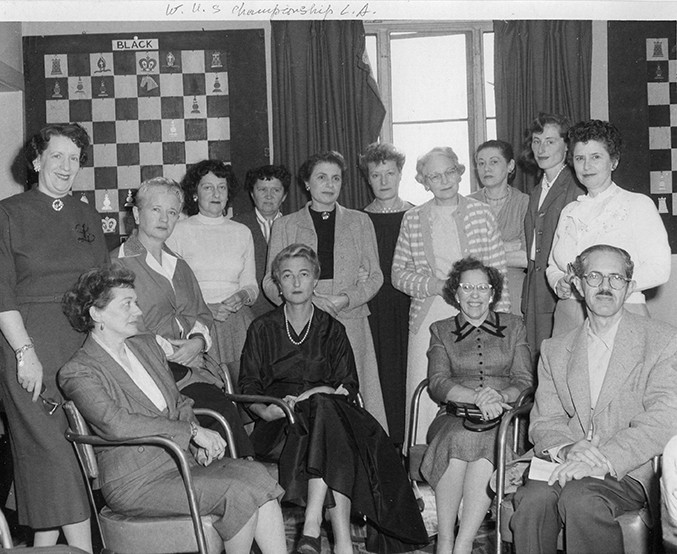
Photographer unknown
Participants in the 1957 Women’s U.S. Chess Championship, November 1957
Photograph
Collection of the World Chess Hall of Fame
In 1957, Jacqueline furthered her accomplishments both as a player and a chess benefactor. The same year that she represented the United States in the first Women’s Chess Olympiad, she was the chairperson of the U.S. Women’s Chess Championship. The Herman Steiner Chess Club hosted the event, which was usually held in New York. This was one of many instances in which Jacqueline’s vision helped establish the West Coast as a chess center of the United States. The participants standing in the back row are, from left to right: Lucille Kellner, Sonja Graf-Stevenson, Gisela Gresser, Olga Higgins, Mary Selensky, Mona May Karff, Eva Aronson, Kathryn Slater, Nancy McLeod, and Lenore Simon. The figures seated are, from left to right: Lina Grumette, Jacqueline Piatigorsky, Mildred Morrel, and Isaac Kashdan.
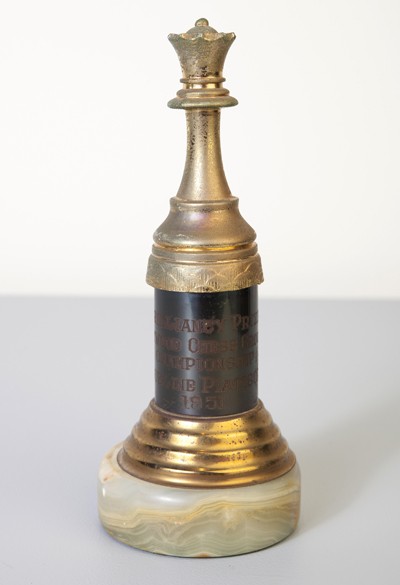
Brilliancy Prize, Hollywood Chess Group “B” Championship 1951
1951
Metal, stone
Collection of the World Chess Hall of Fame, gift of the Family of Jacqueline Piatigorsky
Photo © Michael DeFilippo
Jacqueline received this brilliancy prize trophy for her performance in her first tournament over-the-board at the Hollywood Chess Group. Though she wrote in her memoir Jump in the Waves that her overall performance in the competition had been middling, her beautiful combinations were impressive enough to earn her this prize. She soon began to participate in tournaments with increasing frequency, on the local, state, and national levels.
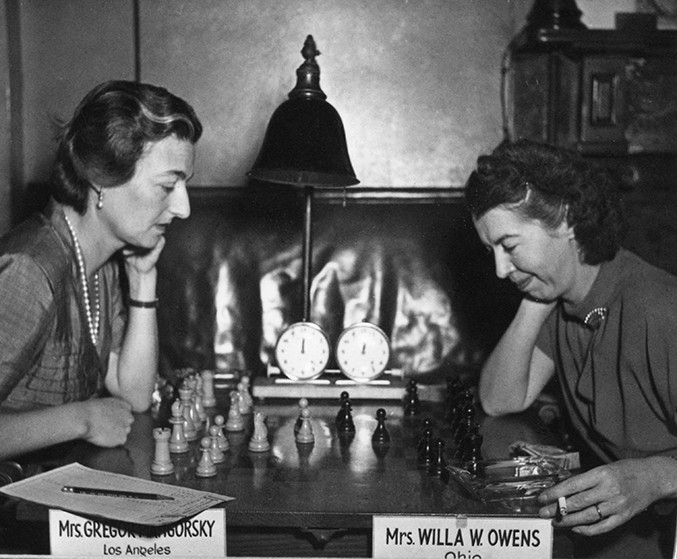
Nancy Roos
Jacqueline Piatigorsky and Willa Owens in the Opening Phase of their Game from the 1951 U.S. Women’s Championship
1951
Photograph
Collection of the World Chess Hall of Fame
Jacqueline has just made the move 4.Ngf3 and awaits her opponent’s reply in this photo taken during the 1951 U.S. Women’s Championship held at the Marshall Chess Club. Though she tied for eighth place (in a field of ten players) Jacqueline attracted attention for this game, in which she defeated Owens in only ten moves. A writer for the New York Times noted that after quickly dispatching her opponent, she left to watch her husband, Gregor, perform Hayden’s cello concerto with the New York Philharmonic at Carnegie Hall. Herman Steiner, Jacqueline’s friend and coach, sponsored her entry into the Championship even though she was still a newcomer to over-the-board competitions.
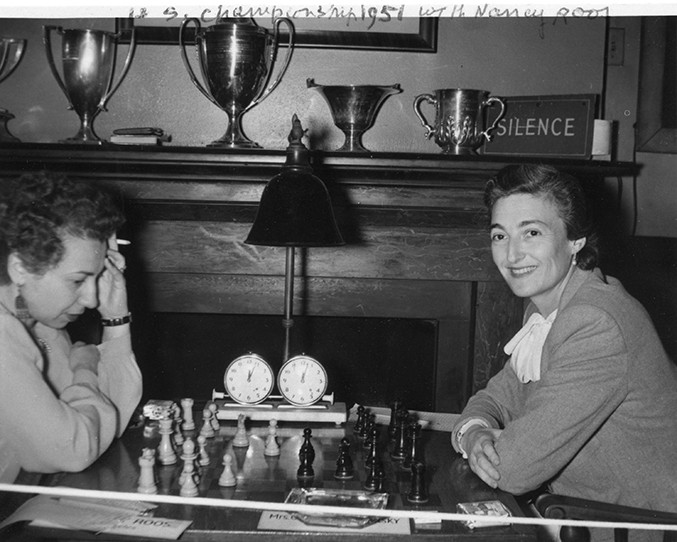
Photographer unknown
Nancy Roos Contemplates her Position during a Game with Jacqueline Piatigorsky at the 1951 U.S. Women’s Chess Championship
1951
Photograph
Collection of the World Chess Hall of Fame
Jacqueline poses for a photograph while her opponent, Nancy Roos, contemplates her position during the 1951 U.S. Women’s Chess Championship at the Marshall Chess Club. The event was Jacqueline’s first championship, but it would not be her last—she participated in the events several more times during the 1950s and 1960s. Roos, who would later tie for first with Gisela Gresser in the 1955 U.S. Women’s Championship, was not only a talented player, but also a professional photographer whose work appeared frequently in Chess Review, Chess Life, and the California Chess Reporter.
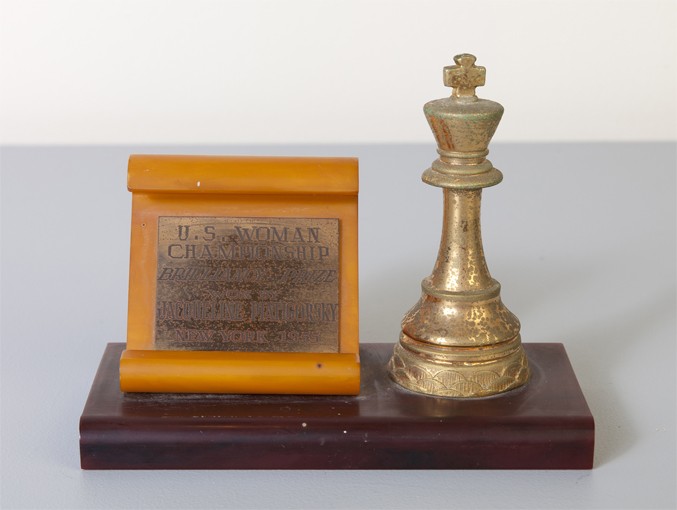
1955 U.S. Women’s Championship Brilliancy Prize
1955
Bakelite, metal
Collection of the World Chess Hall of Fame
Photo © Michael DeFilippo
Jacqueline won this prize in part for her opening round victory over defending champion Mona May Karff. This game proved to be very important for the final standings as Karff just missed finishing first, ending on 8 ½ - 2 ½, just behind Nancy Roos and Gisela Gresser who shared the title with 9-2 scores. Jacqueline, who missed the 1953 U.S. Women’s Championship, made a dramatic improvement over her performance in 1951, moving up from 8-9 (of 10) to 4th (of 12) with an excellent score of 8-3.
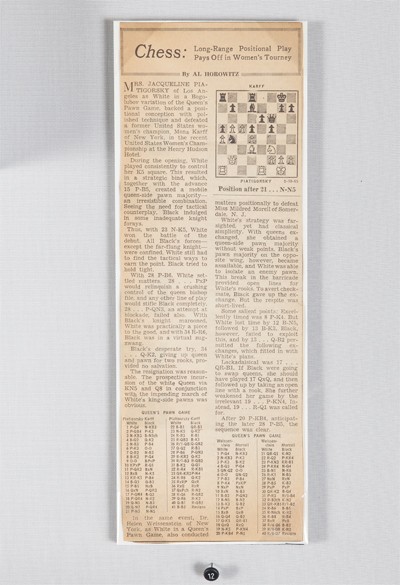
Al Horowitz
“Chess: Long-Range Positional Play Pays Off in Women’s Tourney”
New York Times, May 10, 1965
Newspaper Article
Collection of the World Chess Hall of Fame
Photo © Michael DeFilippo
The 1965 U.S. Women’s Chess Championship was the apex of Jacqueline’s chess career in the United States. In this tournament, she placed half a point out of first, just behind Gisela Gresser. Her impressive finish in her game against rival Mona May Karff, 2013 inductee to the U.S. Chess Hall of Fame, led Al Horowitz, New York Times chess columnist and member of the U.S. Chess Hall of Fame, to publish it in his column.
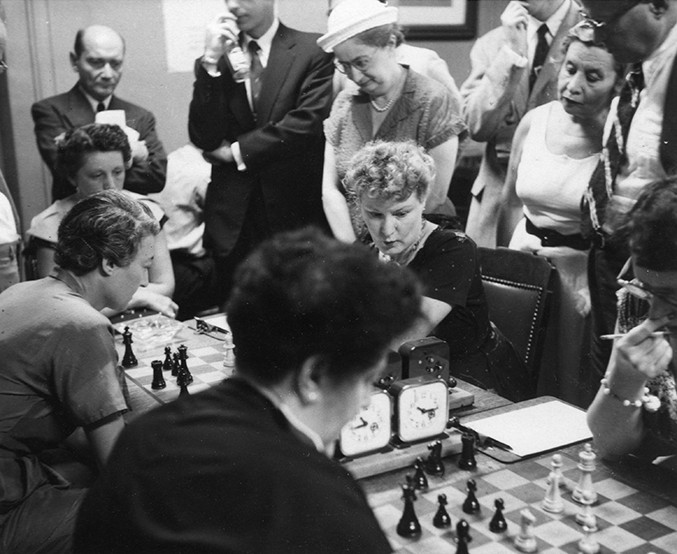
Jacqueline Piatigorsky in Action against Mona May Karff in the 1955 U.S. Women’s Championship
1955
Photograph
Collection of the World Chess Hall of Fame
A crowd gathers at the 1955 U.S. Women’s Chess Championship to watch the newcomer to the competition, Jacqueline, compete against Mona May Karff, then a five-time U.S. women’s chess champion. The majority of the event was held at the Marshall Chess Club; however, this round took place at the Log Cabin Chess Club in West Orange, New Jersey. Though Jacqueline began competing in tournaments later in life than Karff, she still scored victories against Karff during the U.S. Women’s Chess Championships in the 1950s and 1960s.
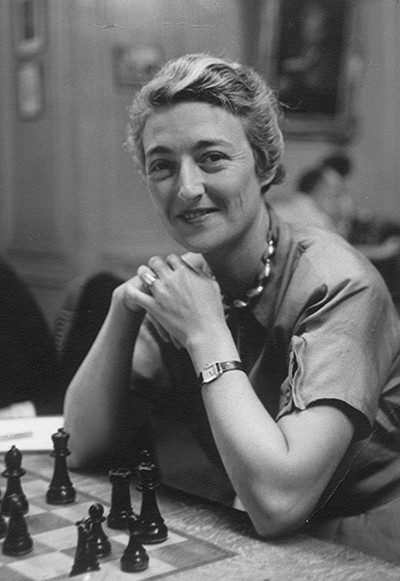
Photographer unknown
Jacqueline Piatigorsky
Date unknown
Photograph
Collection of the World Chess Hall of Fame
In her 1988 memoir, Jump in the Waves, Jacqueline wrote, “Chess had an obsessional grip on me, chess was my friend, my support. Chess was a refuge from unfairness. It had become part of my blood. Still, today, when I am exhausted and sad, when hope disappears, my natural impulse is to flop in front of a chess board and start pushing pieces. Variations take form; rush forward, retreat, attack, defend—no an error, try again. Interest and vitality reborn flow into combinations, soon become storms, a typhoon in a teacup. It is ironic that chess and its combinations awake a passion, bring life.”
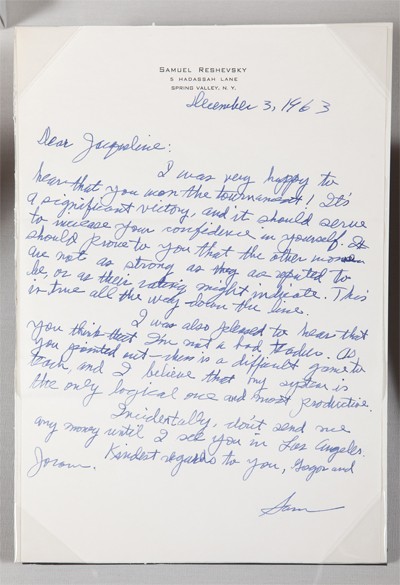
Letter from Samuel Reshevsky to Jacqueline Piatigorsky
December 3, 1963
Manuscript
Collection of the World Chess Hall of Fame
Photo © Michael DeFilippo
Samuel Reshevsky, a 1986 inductee to the U.S. Chess Hall of Fame, offers Jacqueline congratulations on her first place finish in the 1963 Ladies Nevada State Chess Championship in this letter. The two became good friends after the 1961 Bobby Fischer – Samuel Reshevsky match and corresponded throughout the 1960s and 1970s. Jacqueline sent her games to Sammy for his input and her Piatigorsky Foundation provided him with generous financial assistance in the 1960s, supporting his participation in the Interzonal, Zonal playoff, and the 1968 Candidates Match against Viktor Korchnoi.
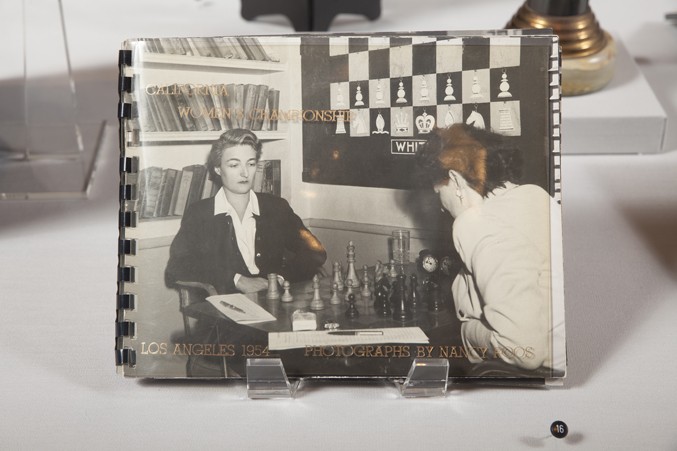
Nancy Roos
California Women’s Championship Los Angeles 1954
1954
Collection of the World Chess Hall of Fame, gift of the Family of Jacqueline Piatigorsky
Photo © Michael DeFilippo
Jacqueline Piatigorsky graces the cover of this book containing photographs of the first official California Women’s Chess Championship. In this photo, she competes against Lina Grumette, a professional publicist. The two players were good friends, and Grumette would later assist Jacqueline in many of her organizational efforts, including the 1961 Bobby Fischer – Samuel Reshevsky match and the 1963 and 1966 Piatigorsky Cups.
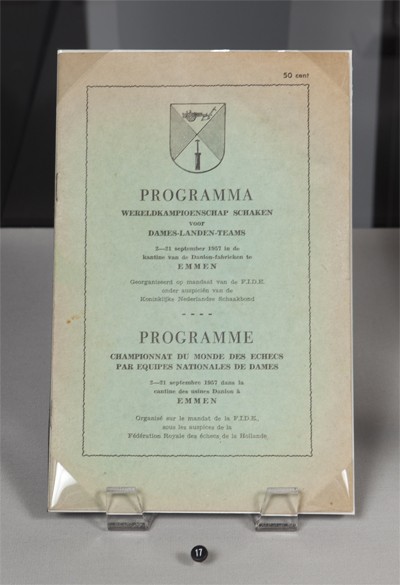
1957 Women’s Chess Olympiad Program
1957
Manuscript
Collection of the World Chess Hall of Fame
Photo © Michael DeFilippo
Jacqueline tracked the results of the competition in this program for the first Women’s Chess Olympiad. H.J. van Steenis, the President of the Royal Dutch Chess Federation, wrote a welcome to the competitors that indicated that organizers hoped that the competitors would “play good chess, feel at home in Emmen and that this tournament will contribute to the good 1957 Women’s Chess Olympiad Program understanding and friendship between all the countries participating in this international event.”
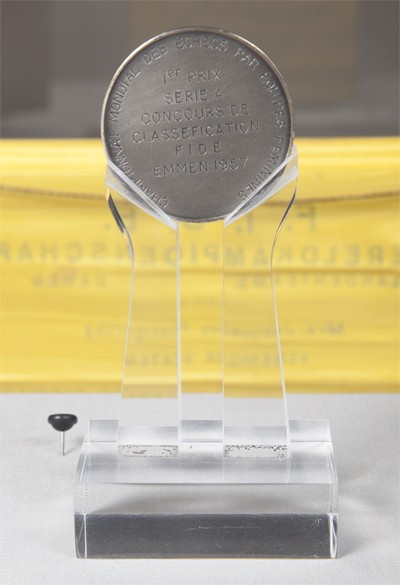
1957 Women’s Chess Olympiad Medal
1957
Collection of the Family of Jacqueline Piatigorsky
Photo © Michael DeFilippo
Jacqueline won this medal for her second-place finish in the 1957 Women’s Chess Olympiad. Though the first official Chess Olympiad for men had been held in 1927, the initial Women’s Chess Olympiad was not organized until 1957. Jacqueline represented the United States with teammate Gisela Gresser. The two placed highest in Group B, placing eleventh overall.
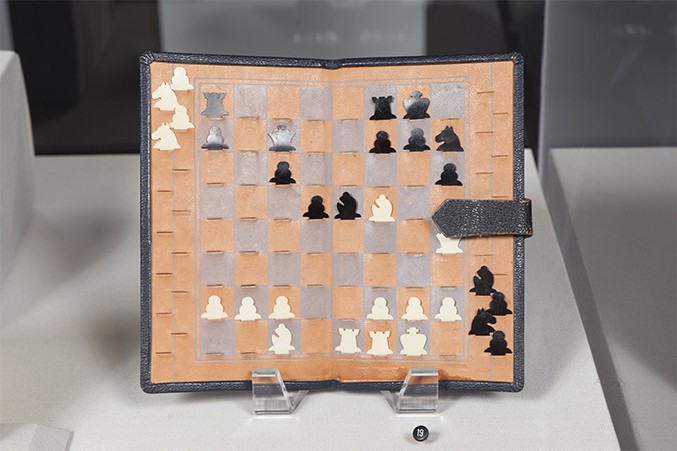
Pocket Chess Set
Leather and plastic
Collection of the World Chess Hall of Fame
Photo © Michael DeFilippo
Played in round three of the preliminaries of the 1957 Women’s Chess Olympiad against Hungarian Womens International Master (WIM) Eva Kertesz, this game was one of the most interesting of the competition. Jacqueline found the beautiful move 22.Bxh6! and could have won with 24.Qh5!—a difficult move to discover without the help of a computer chess engine. The game is displayed on Jacqueline’s pocket chess set, which she used to follow games at tournaments.
Scotch C47
Jacqueline Piatigorsky – Eva Kertesz
Women’s Chess Olympiad (Preliminaries) Emmen 1957
1.e4 e5
2.Nf3 Nc6
3.Nc3 Nf6
4.d4 exd4
5.Nxd4 Bb4
6.Nxc6 bxc6
7.Bd3 d5
8.exd5 cxd5
9.0–0 0–0
10.Bg5 c6
11.Qf3 Be7
12.Rae1 Qc7
13.Ne2 h6
14.Bc1 Bg4
15.Qg3 Bd6
|
16.Qh4 Be5
17.Ng3 Bd7
18.Nf5 Bxf5
19.Bxf5 Nh7
20.Bxh6! gxh6
21.Qxh6 f6
22.f4 Bxb2
23.Rf3 Kh8
24.Qxh7+ Qxh7
25.Bxh7 Kxh7
26.Re7+ Kh6
27.Rh3+ Kg6
28.f5+ Kxf5
29.Rf3+ Draw
|
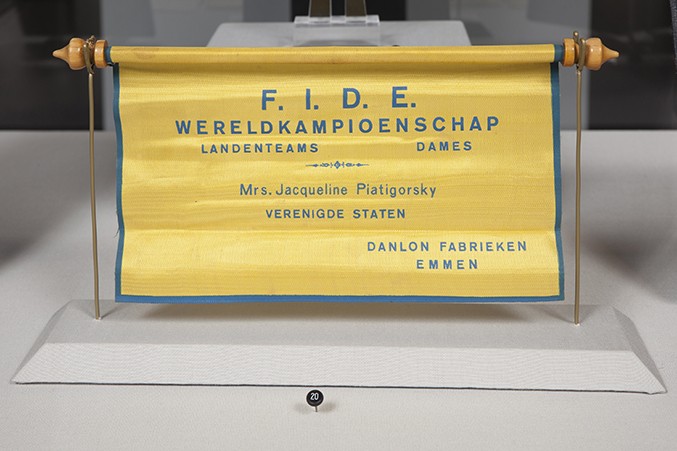
Flag from 1957 Womens Chess Olympiad
1957
Fabric and wood
Collection of the World Chess Hall of Fame
Photo © Michael DeFilippo
This flag, which identifies Jacqueline, can be seen in a photograph of her in the 1957 Women’s Chess Olympiad in the slideshow that accompanies this exhibition. The first Women’s Chess Olympiad was held in Emmen, the Netherlands, not far from the German border. Unlike Women’s Olympiads today, which are played on four boards with a reserve player, in Emmen each team had only two players and no reserves so both players played every match.
Jacqueline’s teammate was the legendary Gisela Gresser, the first American woman to earn the Master rating (2200) and a 1992 inductee to the U.S. Chess Hall of Fame. Despite learning the game in her thirties, Gresser won a still-record nine U.S. Women’s Championships, the last at the age of 63. The two teammates both won individual bronze medals with the United States the top finisher in the Group B finals.
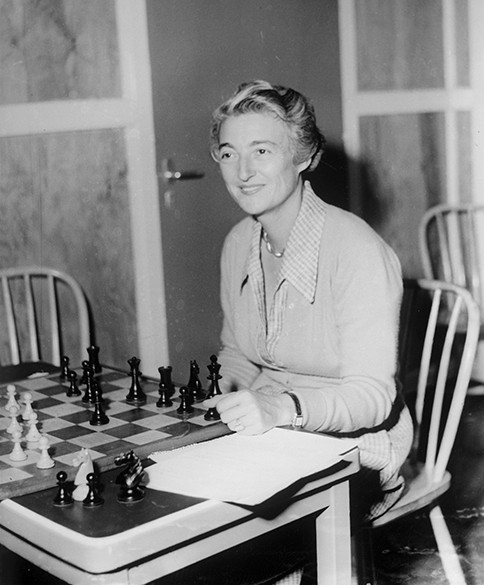
Photographer unknown
Jacqueline at the 1957 Women’s Chess Olympiad, Emmen
1957
Photograph
Collection of the World Chess Hall of Fame
Jacqueline pauses to pose for a photograph during a game in the first Women’s Chess Olympiad in Emmen, the Netherlands. The United States Chess Federation (U.S.C.F.) invited Jacqueline to participate in the competition after fellow Californian Sonja Graf-Stevenson was unable to compete. Jacqueline and her teammate, Gisela Gresser, a 1992 inductee to the U.S. Chess Hall of Fame, won first place in the second group of the competition, placing eleventh in the competition and earning individual bronze medals for their boards.
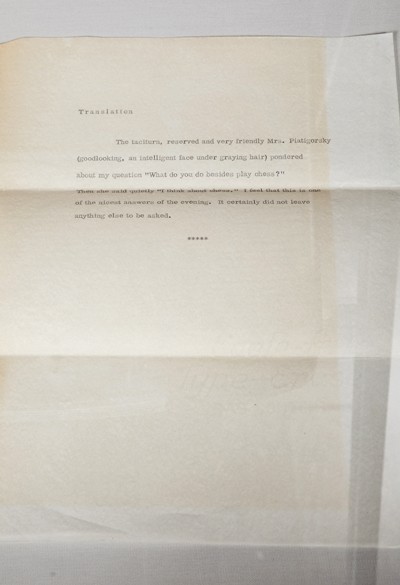
Letter from Peter Fleck to Jacqueline Piatigorsky with Magazine Article
October 22, 1957
Manuscript
Collection of the World Chess Hall of Fame
Photo © Michael DeFilippo
Peter Fleck, Jacqueline’s banker, passes along an amusing article from a Dutch periodical that records the first Women’s Chess Olympiad. The article contains images of the players, including Jacqueline and teammate Gisela Gresser seated with Mevrouw Gaarlandt, the burgemeester of Emmen. Fleck, who was born in the Netherlands but lived in New York, translated Jacqueline’s response to the question, “What do you do besides play chess?” She responded, “I think about chess.”
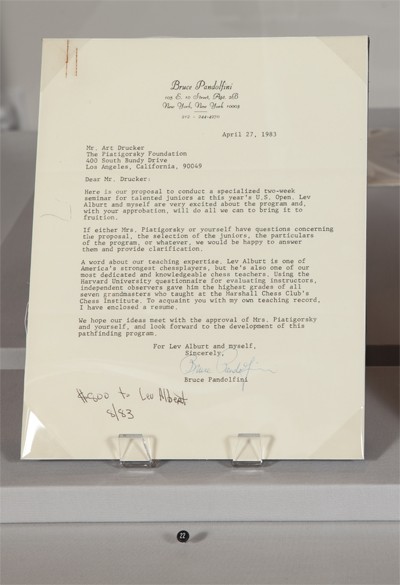
Letter from Bruce Pandolfini to Arthur Drucker
April 27, 1983
Manuscript
Collection of the World Chess Hall of Fame
Photo © Michael DeFilippo
A handwritten note at the bottom of this letter indicates that Jacqueline authorized the Piatigorsky Foundation to provide $800 (equivalent to $1900 today) for a seminar for skilled junior players during the 1983 U.S. Open conducted by Bruce Pandolfini and Lev Alburt. Pandolfini is known as one of this country’s most famous chess authors and teachers. His most famous student is Josh Waitzkin, the subject of the book Searching for Bobby Fischer, which was later made into a film.
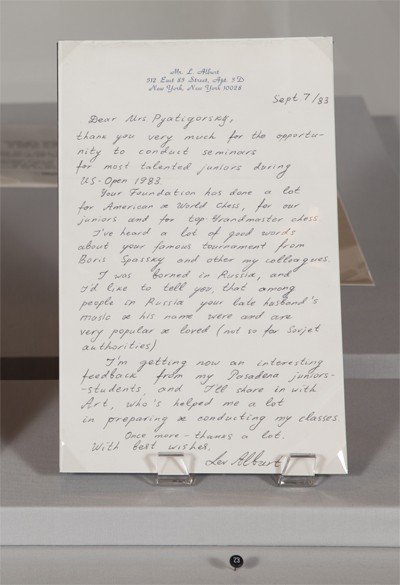
Letter from Lev Alburt to Jacqueline Piatigorsky
September 7, 1983
Manuscript
Collection of the World Chess Hall of Fame
Photo © Michael DeFilippo
Lev Alburt, a three-time U.S. Champion and a 2003 inductee to the U.S. Chess Hall of Fame, thanks Jacqueline for her support of seminars for junior chess players during the 1983 U.S. Open. The Piatigorsky Foundation also organized the U.S. Junior Closed Championship after Jacqueline discovered that the United States had not sent any competitors to the World Junior Chess Championship. In addition to its activities supporting chess for youth, the Piatigorsky Foundation supported the World Championship runs of Samuel Reshevsky and Bobby Fischer.
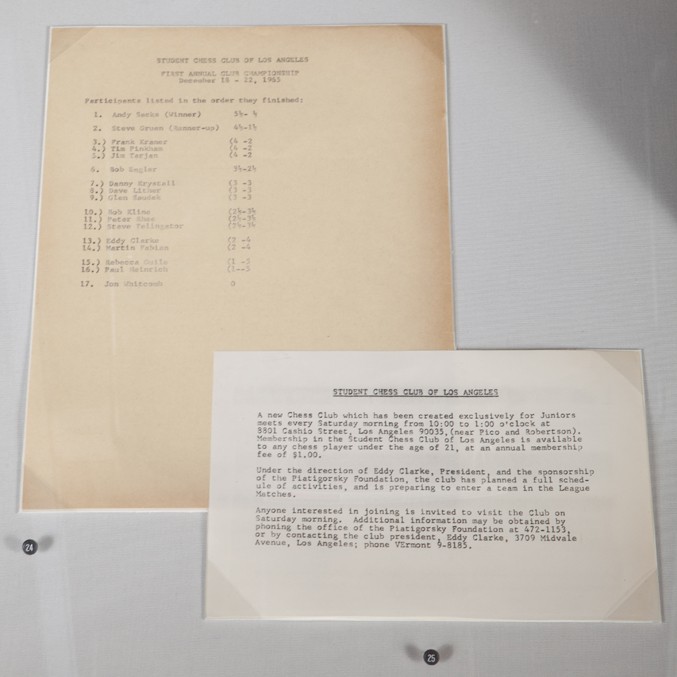
Left: Student Chess Club of Los Angeles Championship Results
December 1965
Manuscript
Right: Student Chess Club of Los Angeles Flyer
1965
Manuscript
Collection of the World Chess Hall of Fame
Photo © Michael DeFilippo
The Student Chess Club of Los Angeles quickly became an important institution for developing junior talent in the Los Angeles area after its founding in 1965. Among the top finishers in its first championship were future Grandmaster James Tarjan, as well as future National Masters Andy Sacks and Danny Krystall. Tarjan and Sacks are among the interviewees in the audio tour for this exhibition.
This flyer advertises the newly-formed Student Chess Club of Los Angeles, a subgroup of the Herman Steiner Chess Club. Established in 1965, the Club was one of the first juniors-only chess organizations in the country. Though the Piatigorsky Foundation was created with the aim of promoting chess generally in the United States, Jacqueline took a great interest specifically in youth chess. The Foundation sponsored many events for young chess enthusiasts in California, which included the state’s Junior Championship, the Tournament of Champions, and Christmas Tournament. The organization also supported chess activities for children living in underserved communities, as well as those for students with physical disabilities.
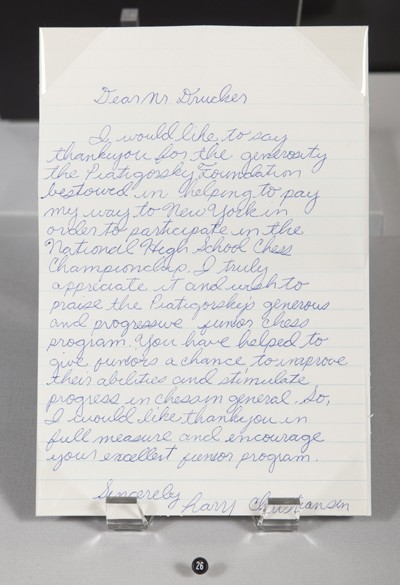
Letter from Larry Christiansen to Arthur Drucker
1971
Manuscript
Collection of the World Chess Hall of Fame
Photo © Michael DeFilippo
This thank you letter from 14-year-old Larry Christiansen exemplifies the Piatigorsky Foundation’s generosity. Besides its support of major events and world class players, the Foundation also helped rising young chess stars. This letter was written to Arthur Drucker, who assisted Jacqueline in running the Piatigorsky Foundation, shortly after Larry had won the 1971 National High School Chess Championship in New York City. A ninth-grader from Riverside, California, Christiansen was the first junior high student to win the event, and would later go on to become a three-time U.S. Champion. He was inducted into the U.S. Chess Hall of Fame in 2008.
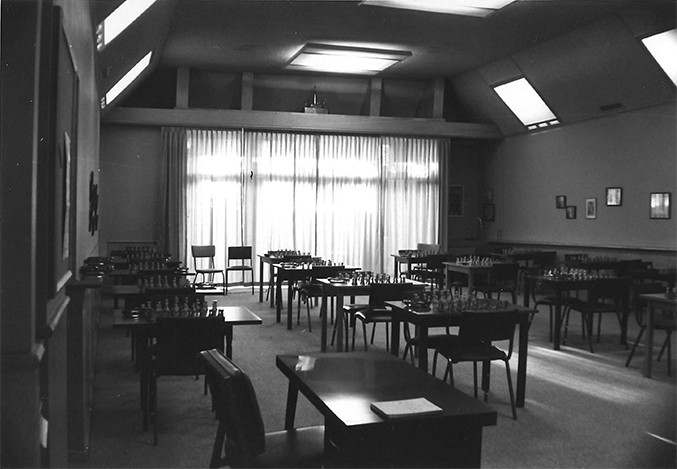
Photographer unknown
Herman Steiner Chess Club
c. 1961
Photograph
Collection of the World Chess Hall of Fame
Designed by noted architect Frank Lloyd Wright, Jr., the open, airy interior of the Steiner Chess Club provided a welcoming atmosphere for tournaments, as well as the group’s daily activities. This location opened on 8801 Cashio Street in Los Angeles, California, in 1961. Its simple, elegant design embodied Jacqueline’s desire to elevate American chess through holding events and daily activities in beautiful environments.
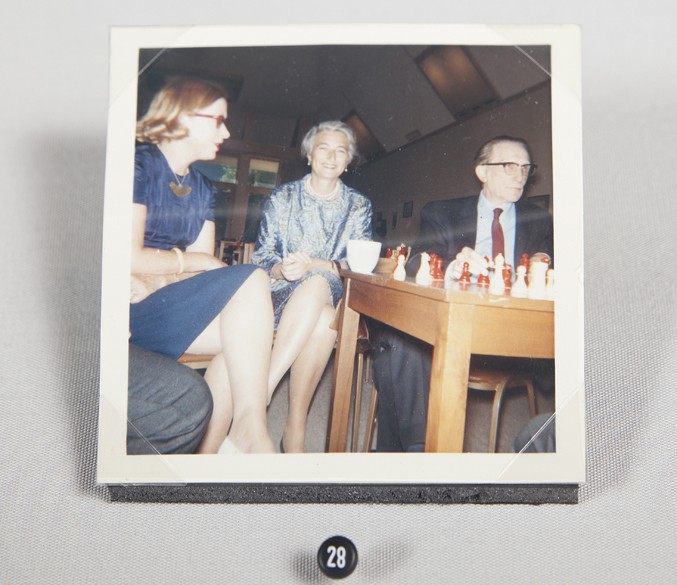
Photographer unknown
Jacqueline Piatigorsky with Marcel and Alexina “Teeny” Duchamp at the Herman Steiner Chess Club
October 12, 1963
Photograph
Collection of the World Chess Hall of Fame
Photo © Michael DeFilippo
Marcel Duchamp, one of the greatest artists of the twentieth century and a French Master, plays a game while his wife, Teeny, and Jacqueline watch at the Herman Steiner Chess Club. Duchamp had great respect for chess champions and, like the Piatigorsky Foundation, offered support to Bobby Fischer. Jacqueline organized events like the first Piatigorsky Cup, held the same year this photograph was taken, in order to elevate the status of the Herman Steiner Chess Club. These events attracted the attention both of the greatest chess players and celebrity chess enthusiasts.
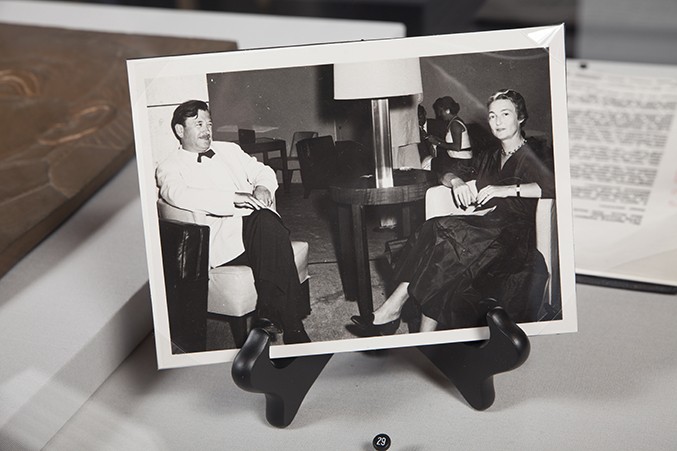
Photographer unknown
Jacqueline Piatigorsky and Herman Steiner, c. 1951 - 1955
Photograph
Collection of the World Chess Hall of Fame
Photo © Michael DeFilippo
Herman Steiner, pictured at left, was not only a great player but also a great chess promoter. Born in present-day Slovakia, Steiner moved at an early age to New York where he learned to play and developed into one of the best players in the country, representing the United States in the 1928 and 1930 Chess Olympiads. Soon after, with many chess professionals trying to eke out a living in New York City during the Great Depression, future U.S. Women’s Champion Mary Bain advised Steiner to seek his fortune in Los Angeles. This proved to be wise counsel as he soon became the columnist for the Los Angeles Times and founded a chess club, the Hollywood Chess Group. He also made connections in Hollywood and celebrities like Humphrey Bogart became fixtures at his events.
Herman Steiner’s influence on Jacqueline Piatigorsky was profound. An excellent teacher with a positive and upbeat personality, Steiner was the right match for Jacqueline whom he encouraged to play aggressively. Like many latecomers to the game she was prone to blunders, but Jacqueline could also play like a master at times, producing sparkling combinations and beautiful attacks that paid homage to her mentor. Jacqueline lost not only a great teacher but a dear friend with Steiner’s sudden death in 1955.
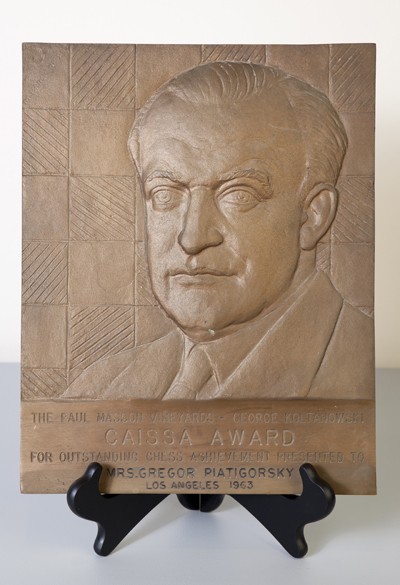
Marian Brackenridge
Caïssa Award
1963
Bronze
Collection of the World Chess Hall of Fame
Photo © Michael DeFilippo
Instituted in 1962, the Caissa award was instituted by George Koltanowski and Paul Masson Vineyards in order to honor “a chosen few men or women who do a wonderful job of promoting the cause of Caissa.” Named for the goddess of chess, the award bears the likeness of Koltanowski, known as the “dean of American chess” and a member of the U.S. Hall of Fame. The award celebrates Jacqueline’s accomplishments as a co-sponsor of the 1961 Bobby Fischer – Samuel Reshevsky match, a supporter of the Steiner Chess Club, and financial contributor to the American Chess Foundation. The same year that she won this award, she organized the first Piatigorsky Cup.
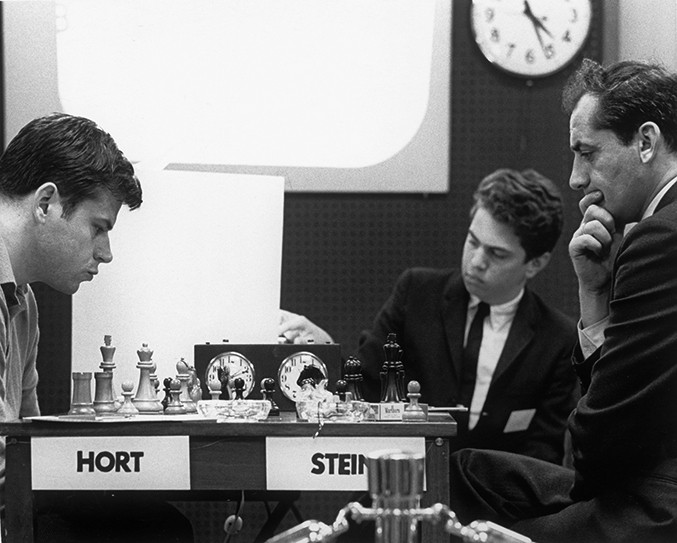
Art Zeller
Leonid Stein and Vlastimil Hort at the 1967 Interzonal Playoff
1968
Photograph
Collection of the World Chess Hall of Fame
The last competition the Piatigorskys hosted was the playoff for the final spot in the Candidates Tournament from the 1967 Interzonal. The Candidates Tournament would determine the challenger of the reigning world chess champion, Boris Spassky. Held in February-March 1968, it pitted American Samuel Reshevsky against Leonid Stein of the Soviet Union and Vlastimil Hort of Czechoslovakia. Each player faced the other four times and at the end of the competition they were tied at 4-4. Reshevsky advanced to the Candidates by virtue of his better tie-break from the Interzonal. The tournament utilized the same projector system of illustrating the games that had been used in the 1966 Piatigorsky Cup. The wall-boy in the background is future Grandmaster and U.S. Olympiad team member James Tarjan, who shares his memories of Jacqueline Piatigorsky and the Steiner Club in the audio tour for this exhibition.
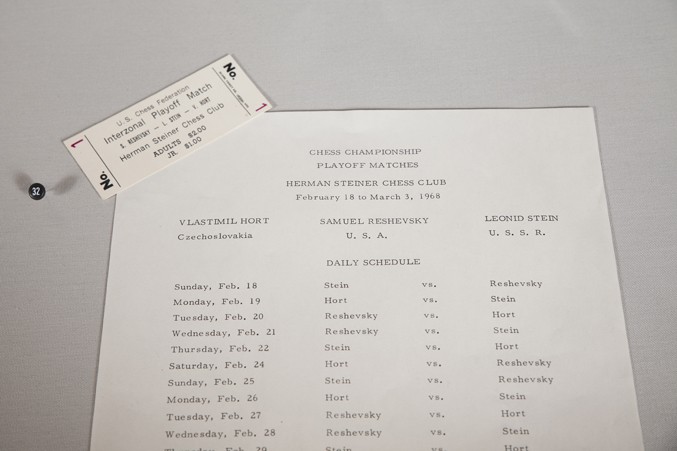
1968 Interzonal Playoff Ticket and Poster
1968
Collection of the World Chess Hall of Fame
Photo © Michael DeFilippo
Unlike the 1963 and 1966 Piatigorsky Cups, the 1968 Interzonal Playoff did not attract a large number of spectators, likely because only one game was played at a time. This event was not only the last major chess competition organized by the Piatigorskys, but also the swan song for the Steiner Chess Club. Jacqueline stopped supporting the Club in the late 1960s.
Isaac Kashdan, a 1986 inductee to the U.S. Chess Hall of Fame, served as the tournament director for many of Jacqueline Piatigorsky’s organizational efforts, including the 1968 Interzonal Playoff and both Piatigorsky Cups. The competition featured three-time Soviet chess champion Leonid Stein’s only appearance on American soil. Stein was one of the top ten players in the world throughout the 1960s and early 1970s. Tragically he was never able to show his full potential, dying from a heart attack in 1973 at the age of 38. Czechoslovakian Vlastimil Hort was only 24 at the time of the Interzonal Playoff but already one of the best players in the world—a position he would occupy until the early 1980s when he left his homeland for Germany. Samuel Reshevsky’s qualification from this event surprised many as he was 56, long past the age when most players dream of competing for the World Chess Championship.
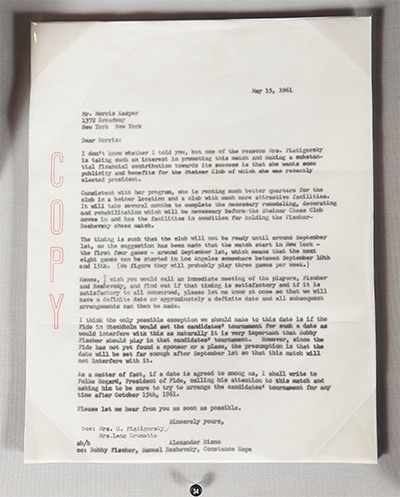
Letter from Alexander Bisno to Morris Kasper
May 15, 1961
Manuscript
Collection of the World Chess Hall of Fame
Photo © Michael DeFilippo
Jacqueline Piatigorsky co-sponsored the 1961 Bobby Fischer – Samuel Reshevsky match in order to promote the soon-to-open location of the Herman Steiner Chess Club on Cashio Street in Los Angeles, California. This letter, written by Alexander Bisno, a businessman and founding president of the American Chess Foundation, elaborates upon her reasons for supporting the event. The competition was to be held partly in New York, where it was supported by the Manhattan Chess Club, and Los Angeles, where the Herman Steiner Chess Club would host the two elite American players.
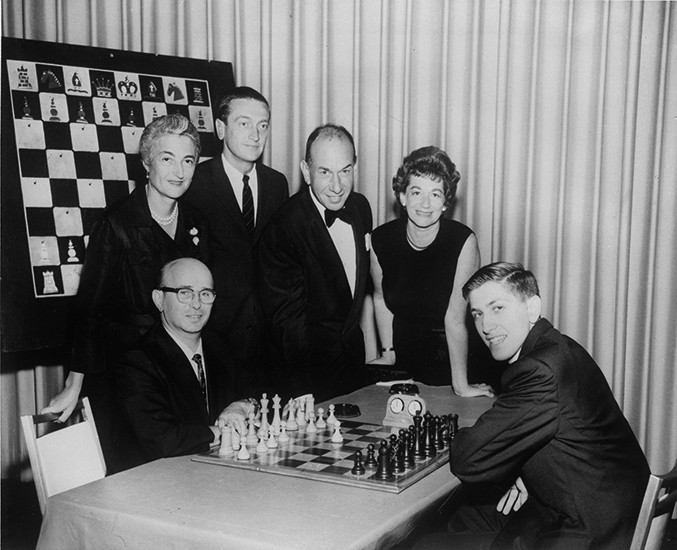
Photographer unknown
Samuel Reshevsky, Jacqueline Piatigorsky, unknown, Jose Ferrer, Lina Grumette, and Bobby Fischer at the Outset of the 1961 Fischer—Reshevsky Match
1961
Photograph
Collection of the World Chess Hall of Fame
Jacqueline Piatigorsky, an unidentified man, actor José Ferrer, and Lina Grumette pose with Samuel Reshevsky and Bobby Fischer at the outset of their 1961 match. The Steiner Chess Club co-organized the match with New York’s Manhattan Chess Club. Though the match began in an exciting manner, it ended abruptly after Bobby Fischer disagreed with Jacqueline about the proposed start time for one of the games. Though this event ended prematurely, it did not dampen Jacqueline’s enthusiasm for organizing tournaments. Two years later she would hold the 1963 Piatigorsky Cup, in which Samuel Reshevsky competed along with seven other top grandmasters.
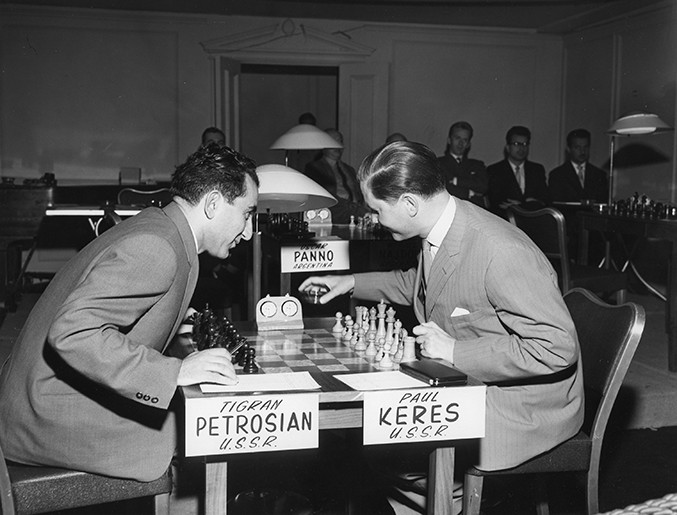
Otto Rothschild
Tigran Petrosian and Paul Keres Exchange Some Friendly Words before Beginning their First Round Game in the Piatigorsky Cup Tournament
1963
Photograph
Photo courtesy Department of Special Collections, Charles E. Young Research Library, University of California, Los Angeles
Paul Keres and Tigran Petrosian prepare for their game, as the other competitors, seated in the background, watch from the back of the stage. In addition to offering the two Soviet players a spirited competition, the Piatigorsky Cup tournament afforded them a chance to enjoy American culture. In his book co-written by International Master Jeremy Silman, Pal Benko: My Life, Games, and Compositions, Pal Benko stated that Petrosian and Keres had hoped to visit Disneyland during their stay in the United States. However, the Soviet Premier, Nikita Khrushchev, was also in the country at the time, and had been denied free entry to the park. The two players abandoned their plans to visit in order to avoid upsetting Soviet officials.
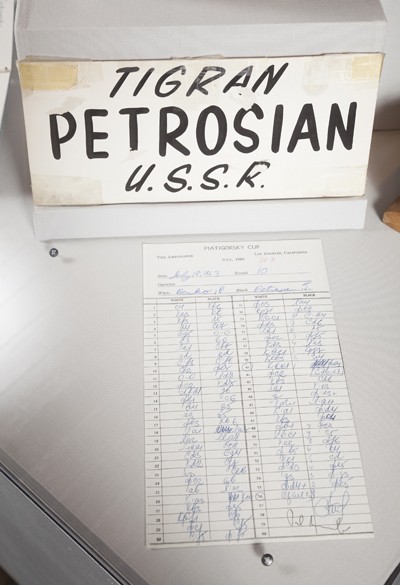
Tigran Petrosian Name Card
1963
Painted board
Pal Benko—Tigran Petrosian, Round 10 Scoresheets
July 18, 1963
Manuscript
Collection of the World Chess Hall of Fame
Photo © Michael DeFilippo
When asked by a reporter why he chose to participate in the Piatigorsky Cup, Tigran Petrosian responded, “Keres and I came to Los Angeles because, like every chessplayer [sic], we enjoy playing chess. The better the opposition, the better I like it, and the Piatigorsky Cup promises to be one of the best international events. All seven opponents are hard and good players.”
“This game was played in the tenth round when my position in the tournament was far from brilliant,” stated Tigran Petrosian in First Piatigorsky Cup: International Grandmaster Chess Tournament in the United States (1963). He won this critical game and played strongly the rest of the way to finish the tournament in a tie for first with Paul Keres. Tigran Petrosian’s strong defenses earned him the nickname of the “Iron Tiger."
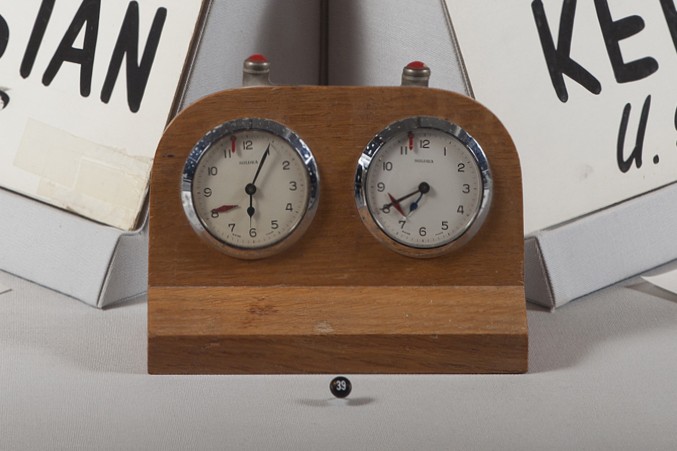
Solora Chess Clock
c. 1963
Wood, metal, and glass
Collection of the World Chess Hall of Fame
Photo © Michael DeFilippo
Made in Switzerland, this clock was a favorite of United States Chess Federation (U.S.C.F.) tournament players during the 1950s and 1960s. Though this one belonged to Jacqueline Piatigorsky, the same style of clock was used by the players in the 1963 Piatigorsky Cup tournament, as can be seen in the photographs of Paul Keres and Tigran Petrosian on view in this exhibition.
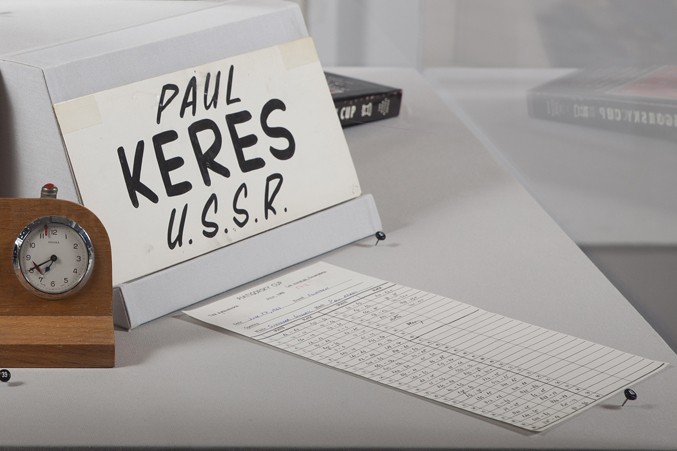
Paul Keres Name Card
1963
Painted board
Svetozar Gligoric—Paul Keres, Round 14 Scoresheets
July 28, 1963
Manuscript
Collection of the World Chess Hall of Fame
Photo © Michael DeFilippo
Paul Keres said of his experiences in the Piatigorsky Cup: “It is always easy to explain or to alibi losses, but my opponents played very well and I think that I may have lost these games without any illness. Playing in the First Piatigorsky Cup Tournament and sharing top place with the World Champion is a wonderful experience. I enjoyed not only the fighting chess, but especially the friendly atmosphere and the extremely well-organized event. Many fine and famous players will win and have their names engraved upon this Cup in years to come. I am deeply happy to share this honor with the winners to follow.”
The most important game of the tournament for Paul Keres, this contest ended with his victory over Svetozar Gligoric. Keres needed to win to have a chance to catch up with Tigran Petrosian, who was leading him by half a point going into the last round. At the halfway point of competition, Gligoric had been tied with Keres and Miguel Najdorf for first. However, by this point in the event, Gligoric and Najdorf had slipped down in the standings, while Petrosian’s strong play led him to the top spot.
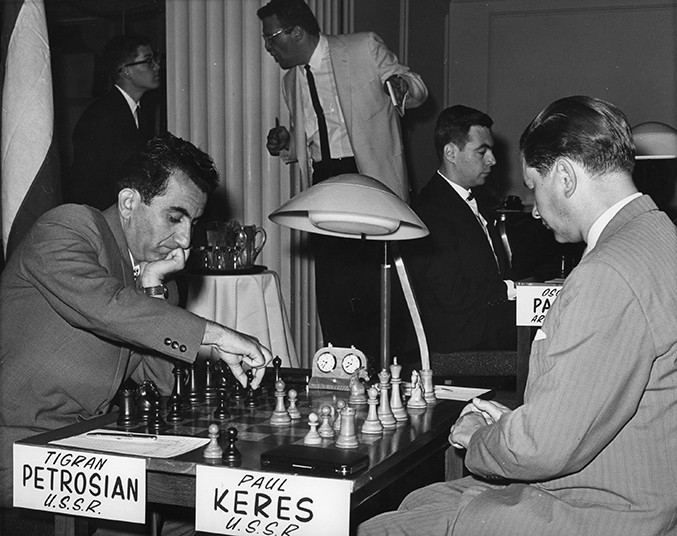
Otto Rothschild
Tigran Petrosian and Paul Keres in the Opening Stage of their First Round Game of the Piatigorsky Cup Tournament
1963
Photograph
Collection of the World Chess Hall of Fame
In the foreground, the two Soviet competitors, Tigran Petrosian and Paul Keres, play, while the Argentinian Oscar Panno can be seen seated in the background during his game against his fellow countryman Miguel Najdorf. Petrosian and Keres fought to a draw in their opening game.
The first round of the 1963 Piatigorsky Cup pitted the three pairs of competitors from the same nations against each other so that they would not meet in the final stage of the tournament. This is a long established practice in major events to protect compatriots from potential allegations of collusion. American players Pal Benko and Samuel Reshevsky, were also paired. Rounding out the field, Svetozar Gligoric and Fridrik Olafsson, the only representatives of their respective countries (Yugoslavia and Iceland), also faced off at the beginning of the strongest tournament held on American soil since the New York 1924.
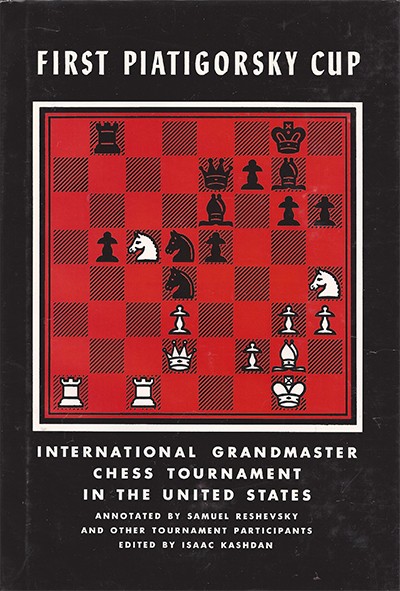
Isaac Kashdan, editor
First Piatigorsky Cup: International Grandmaster Chess Tournament in the United States
Los Angeles: Ward Ritchie
1965
Collection of the World Chess Hall of Fame
An important record of the proceedings of the 1963 Piatigorsky Cup, the tournament book contains annotations of games primarily written by Samuel Reshevsky. The other players in the competition contributed notes to their key efforts. It also includes a foreward by the tournament’s director, Isaac Kashdan, as well as photographs of the competition’s exciting proceedings.
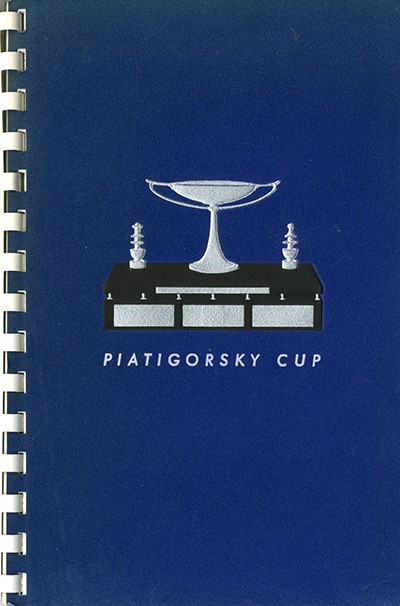
First Piatigorsky Cup Program
1963
Pamphlet
Collection of the World Chess Hall of Fame
The program for the first Piatigorsky Cup contains the schedule of events, as well as biographies and photos of each of the players. It also includes the biography of Vikltor Korchnoi, reigning Soviet champion, who was the alternate for the tournament. When the Piatigorsky Cup was scheduled, the dates for the World Championship match between Mikhail Botvinnik and Tigran Petrosian were not known. There was a chance Petrosian would not be able to play in Los Angeles because of the potential for the events to overlap. Petrosian was ultimately able to participate, and so Korchnoi did not travel to Los Angeles for the competition.
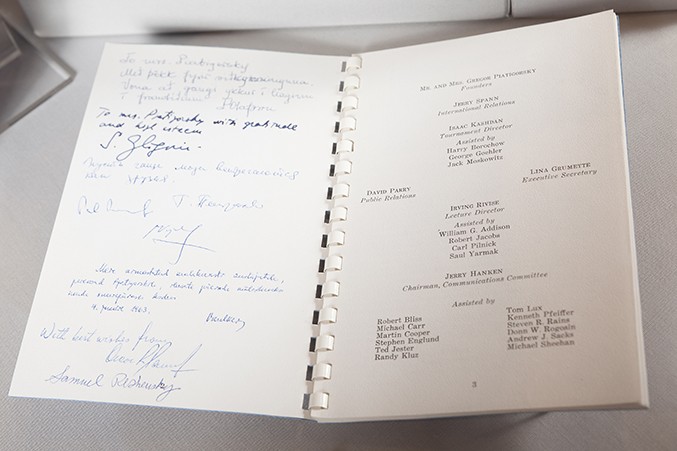
Inscribed First Piatigorsky Cup Tournament Program
1963
Pamphlet
Collection of the World Chess Hall of Fame
Photo © Michael DeFilippo
Participants in the 1963 Piatigorsky Cup inscribed this copy of the program for Jacqueline Piatigorsky. Many of the competitors maintained warm relationships with her after the conclusion of the tournament and corresponded with her in the following years.
Additionally, the program features images of letters from Pierre Salinger, the press secretary during the administration of President John F. Kennedy; Governor Edmund G. Brown of California; and the mayor of Los Angeles, Sam Yorty. These political figures praised the Piatigorsky Cup tournament and predicted that it would have a positive legacy both in the world of chess and for the United States as a whole.
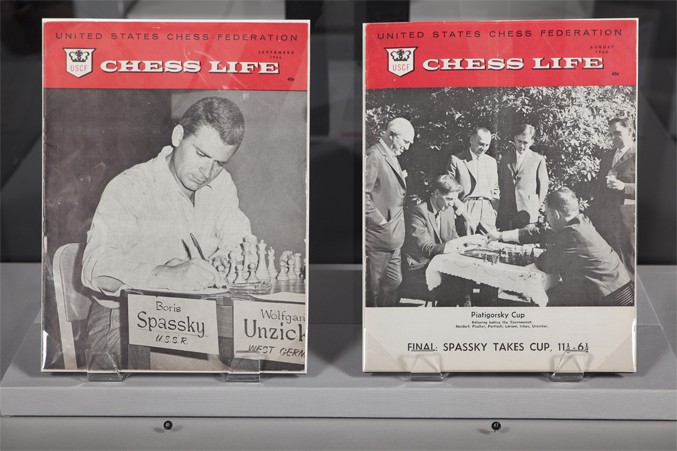
Chess Life, September 1966
Chess Life, August 1966
Magazines
Collection of the World Chess Hall of Fame
Photo © Michael DeFilippo
Boris Spassky, the winner of the 1966 Piatigorsky Cup, writes on his scoresheet, in the photo on the cover of this issue of Chess Life. The article within has a colorful description of the tournament, including one anecdote about a man who was arrested at the tournament’s entrance. Unhappy that the viewing area was already at capacity, he struck National Master (NM) Jerry Hanken, a tournament official. It also described how Jacqueline had created index cards with improvements for a third Piatigorsky Cup tournament, which ultimately was not realized.
Miguel Najdorf, Lajos Portisch, Bent Larsen, and Boris Ivkov watch Bobby Fischer and Wolfgang Unzicker analyze a chess game at a party held at the Piatigorsky home in Los Angeles. This issue of Chess Life features an article about the tournament drawn from the text of the competition’s bulletins.
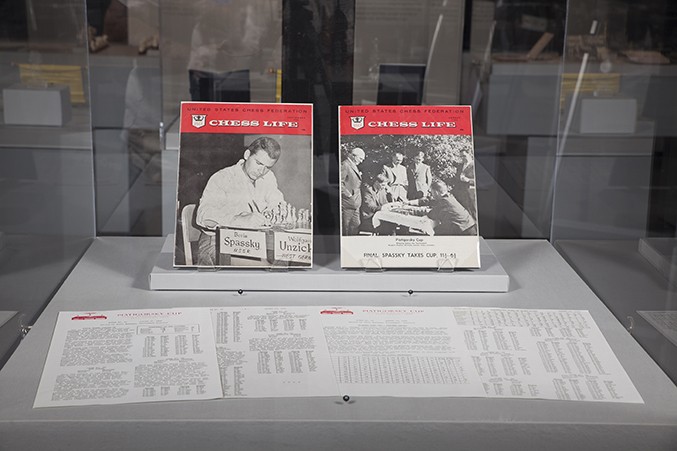
Bottom: Piatigorsky Cup Tournament Bulletins
Round 17, August 14, 1966
Round 18, August 15, 1966
Manuscript
Collection of the World Chess Hall of Fame
Photo © Michael DeFilippo
Both of the Piatigorsky Cups had daily bulletins edited by Isaac Kashdan, which offered color and light annotations to the games. Copies of the bulletins were available for purchase, and chess enthusiasts from around the world purchased them. These issues of the bulletins recount the final two rounds of the tournament, which include Bobby Fischer and Boris Spassky’s drawn game. The two players’ scoresheets for this game are also on view in this exhibition.
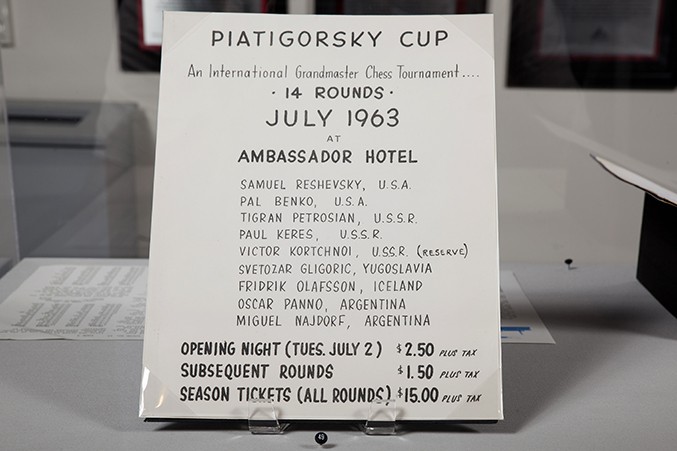
1963 Piatigorsky Cup Poster
1963
Broadside
Collection of the World Chess Hall of Fame
Photo © Michael DeFilippo
This humble handwritten poster advertises one of the greatest twentieth-century American chess competitions. Though the Piatigorsky Foundation sponsored many chess activities in the Los Angeles area, it was best-known for organizing the landmark Piatigorsky Cups. The poster lists the price for a season ticket as $15, an amount that would equal over $100 today.
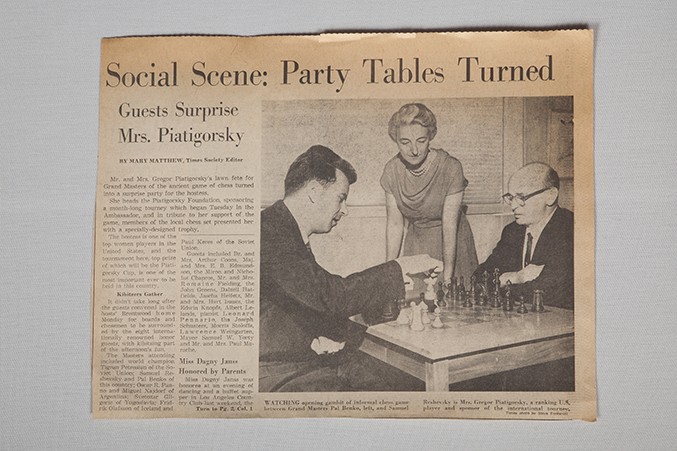
Mary Matthews
“Social Scene: Party Tables Turned”
Los Angeles Times, July 3, 1963
Newspaper article
Collection of the World Chess Hall of Fame
Photo © Michael DeFilippo
This newspaper article, illustrated by a photo of Jacqueline with the two American participants in the 1963 Piatigorsky Cup, details a garden party held by Jacqueline to celebrate the participants in the tournament. Local chess enthusiasts showed their appreciation for her efforts by giving her a trophy designed by sculptor and chess set designer Peter Ganine. Guests to the party included film producer Edwin Knopf, Los Angeles mayor Samuel Yorty, and noted violinist Jascha Heifetz.
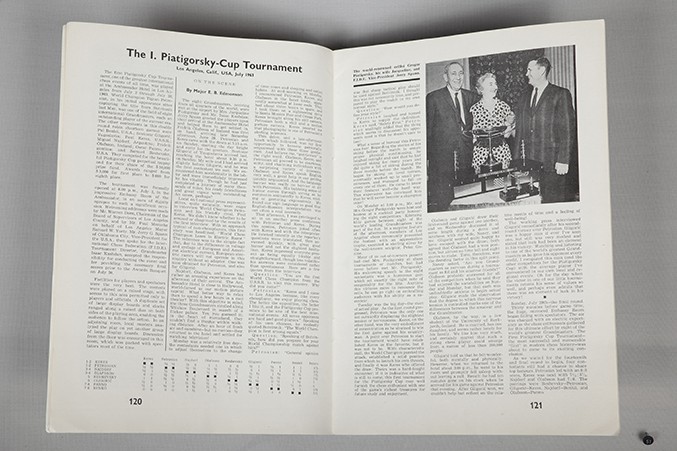
Major E.B. Edmundson
“The I. Piatigorsky-Cup Tournament”
FIDE: revue officielle trimestrielle de la Fédération internationale des échecs, 1963
Magazine
Collection of the World Chess Hall of Fame
Photo © Michael DeFilippo
Ed Edmundson, 1995 inductee to the U.S. Chess Hall of Fame, relates colorful stories about the 1963 Piatigorsky Cup for a publication for FIDE (Fédération internationale des échecs, also known as the World Chess Federation). He describes taking Tigran Petrosian, Paul Keres, and Fridrik Olafsson on a tour of Santa Monica Pier and Ocean Park. He wrote about Petrosian’s passion for photography, as well as the friendly personalities of the three chess stars. “Olafsson, Keres and Petrosian all proved to be courteous, witty, and charming individuals with a surprising variety of interests. Olafsson and Keres speak English very well, a great help in our getting quickly acquainted. And the language barrier was really no barrier at all with Petrosian. His bubbling sense of humor comes through strong as he comments animatedly to Keres, smiling or gesturing expressively. We found our sign language so good that English-Russian interpretation was not often a real necessity.”
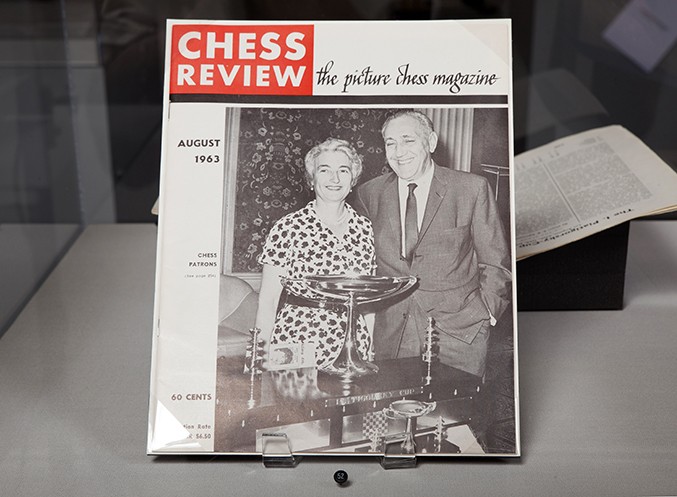
Chess Review, August 1963
Magazine
Collection of the World Chess Hall of Fame
Photo © Michael DeFilippo
Jacqueline and Gregor Piatigorsky are pictured with the Piatigorsky Cup on the cover of this issue of Chess Review. The cover story honors their organizational efforts, details the play of the tournament, and includes stories about the players in the competition. It notes that both Paul Keres and Samuel Reshevsky suffered from the flu during the course of the event.
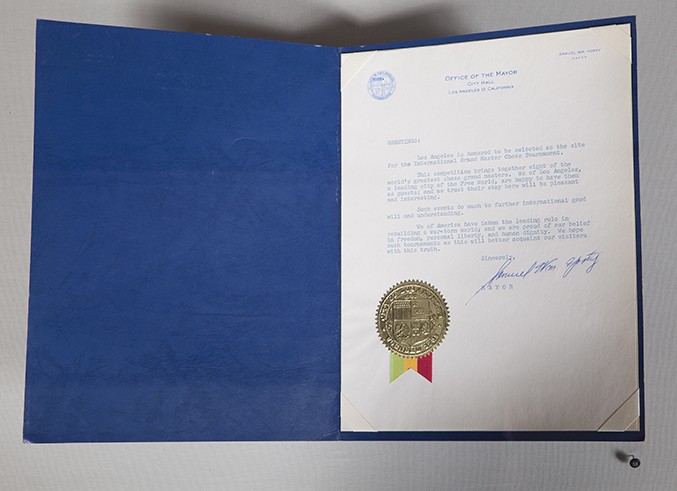
Letter from Los Angeles Mayor Samuel Yorty Commemorating the 1963 Piatigorsky Cup Tournament
1963
Manuscript
Collection of the World Chess Hall of Fame
Photo © Michael DeFilippo
The program for the 1963 Piatigorsky Cup included an image of this letter, which expresses hope that tournaments such as the Piatigorsky Cup could lead to more international cooperation, and ultimately, an improved world. The governor of the state of California, as well as the White House, also wrote letters commemorating the event.
Fifty years later it is easy to forget that the first Piatigorsky Cup was held during the middle of the Cold War, just a year after the Cuban Missile Crisis. The participation of the Soviet participants was uncertain until a few months before the tournament.
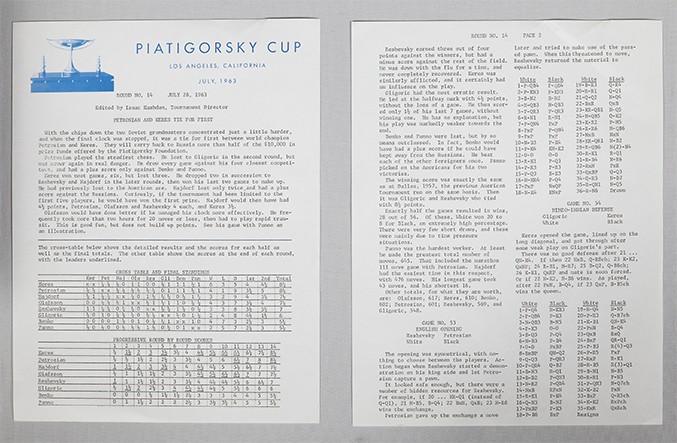
Round Number 14 Bulletin – 1963 Piatigorsky Cup Tournament
July 28, 1963
Manuscript
Collection of the World Chess Hall of Fame
Photo © Michael DeFilippo
Edited by Isaac Kashdan, these bulletins recap the action of the tournament and include amusing anecdotes. They were published for each of the rounds; this one was created after the completion of the tournament, and includes the final standings of the players. An earlier bulletin describes how the tournament was interrupted when a celebrity walked into the tournament area. “Most commotion of the tournament to date was caused when Frank Sinatra and Mike Romanoff walked in. Tigran Petrosian temporarily lost his title as most stared at individual.”
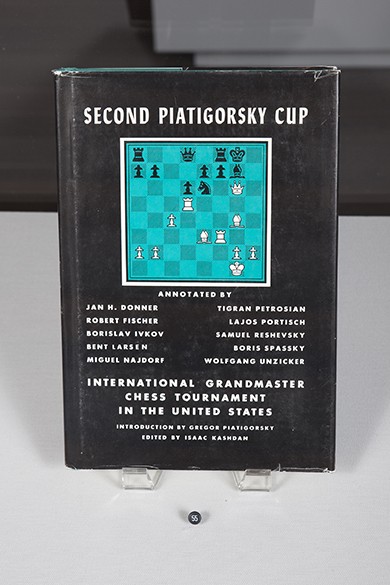
Isaac Kashdan, editor
Second Piatigorsky Cup: International Grandmaster Chess Tournament in the United States
1968
Los Angeles: Ward Ritchie Press
Photo © Michael DeFilippo
Though David Bronstein and Boris Vainstein’s book Zurich International Chess Tournament, 1953 is widely held to be the best tournament book of all time, many chess players believe that Second Piatigorsky Cup is superior. Originally, tournament organizers asked Bobby Fischer to be the primary annotator of the book. When he declined, the organizers settled on an equally compelling and perhaps more revolutionary format: each of the players in the competition annotated their games.
Never before or since has an elite competition been covered in the same way, with both players annotating each game independently of one another. The result is a fascinating work in which readers get two glimpses into what is happening in each game, sometimes with the players contradicting each other. The writers provide insight into the complexity and difficulty of the game. Articles by Isaac Kashdan and Gregor Piatigorsky provide color, while the beautiful black and white photographs memorialize the competition. This book not only has a final crosstable showing the final placement of the contestants, but also a progressive crosstable, a listing of round by round results, and player and opening indices.
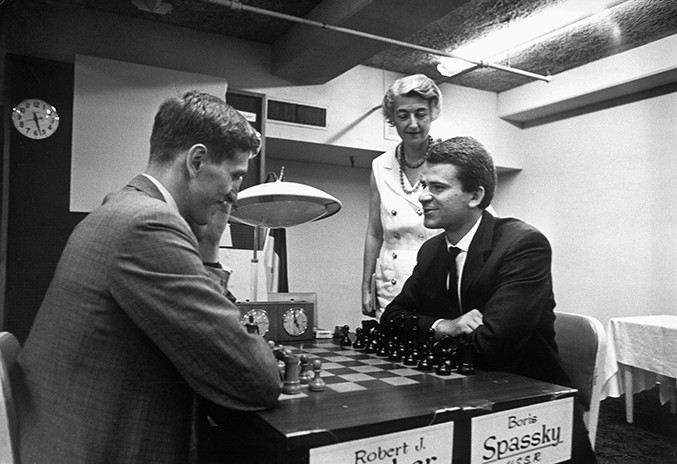
Phil Bath
Jacqueline Piatigorsky Watches Bobby Fischer and Boris Spassky Relax after their Drawn Game in the Penultimate Round of the Piatigorsky Cup Tournament
1966
Photograph
Collection of the World Chess Hall of Fame
Bobby Fischer and Boris Spassky started the tournament well, and after five rounds were tied for first with Lajos Portisch. However, disaster then struck for Bobby, who lost his next three games to fall two and a half points behind Spassky. Things looked bleak, but in the second half of the tournament he mounted a tremendous comeback, winning four games in a row in rounds ten through thirteen. By round sixteen he had caught Spassky. As brilliant as this performance was, Bobby was still in a near must-win situation in this game, as he had black against Tigran Petrosian in the last round, while Boris had white against the tail ender Jan Hein Donner.
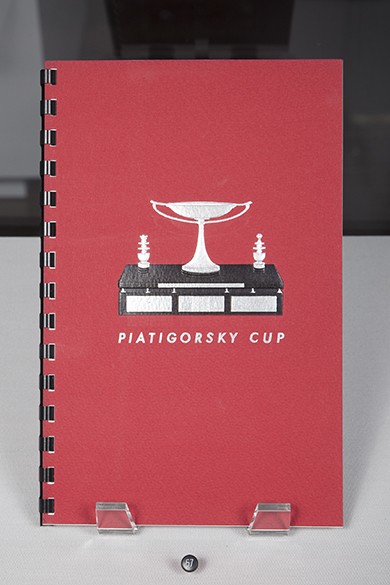
1966 Piatigorsky Cup Tournament Program
1966
Pamphlet
Collection of the World Chess Hall of Fame
Photo © Michael DeFilippo
The cover of the Piatigorsky Cup program illustrates the beautiful silhouette of the Piatigorsky Cup trophy. Inside are biographies of the tournament participants and a schedule of events.
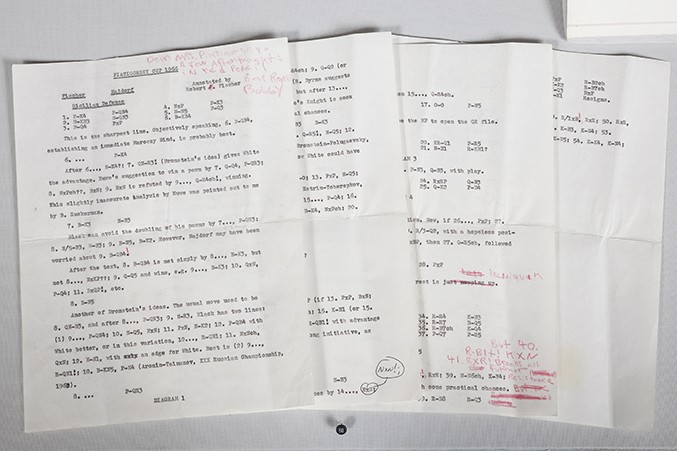
Bobby Fischer’s Annotation of his Game against Miguel Najdorf, Round 16 of the Piatigorsky Cup Tournament
1966
Manuscript
Collection of the World Chess Hall of Fame
Photo © Michael DeFilippo
Unlike the rest of the players, the majority of whom annotated all of their games, Bobby Fischer only commented on one game for the tournament book. Later this work appeared as game fifty-four in My 60 Memorable Games, Fischer’s classic book recounting sixty of his games from 1957 to 1967. The marks in red are Fischer’s corrections in his own hand.
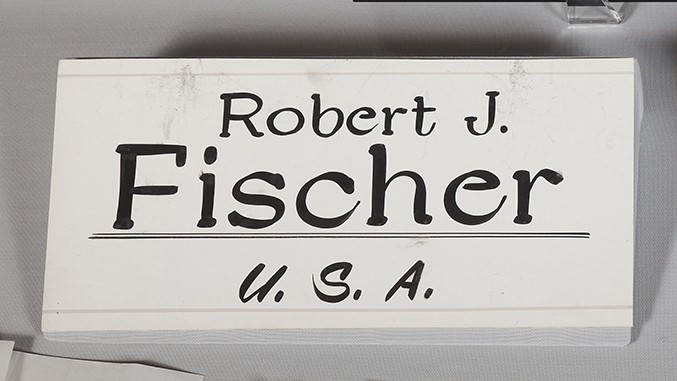
Bobby Fischer Name Card from the Piatigorsky Cup Tournament
1966
Painted board
Collection of the World Chess Hall of Fame
Photo © Michael DeFilippo
Born in 1943, Bobby Fischer and his legendary talent will be remembered as long as the game of chess is played. Like Boris Spassky, with whom he would become so intrinsically linked, Fischer was recognized as a great talent at an early age. U.S. Champion at fourteen and a Candidate at sixteen, it seemed like Bobby would break Mikhail Tal’s then record of age twenty-three for the youngest World Chess Champion, but such was not to be. Like Spassky, he spent a long time building his skill before taking the title in 1972 in what became known as the “Match of the Century.” This chess event captured the attention of the world in a way never since duplicated.
Before the 1966 Piatigorsky Cup, Fischer had competed in few international events following a disastrous performance at the 1962 Candidates Tournament in Curaçao. This lack of activity previous to the Piatigorsky Cup made even Fischer’s supporters doubtful that he would triumph. However, after three straight losses in round six through eight, Fischer mounted one of the greatest comebacks in the history of chess, scoring eight points in ten games against the best players in the world. He finished a close second to Spassky. This result provided a strong boost of confidence for Fischer and one can easily imagine how differently the history of chess would have been written if the second Piatigorsky Cup not been held.
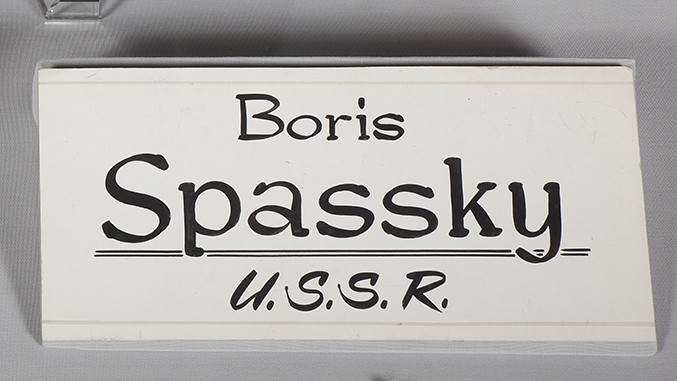
Boris Spassky Name Card from the Piatigorsky Cup Tournament
1966
Painted board
Collection of the World Chess Hall of Fame
Photo © Michael DeFilippo
Born in 1937, Boris Spassky showed great promise at an early age, making a stunning international debut at Bucharest 1953. There he tied for fourth in a strong field at the young age of only 16. A victory in the World Junior Chess Championship in 1955 and qualification to the Candidates tournament the same year suggested Spassky would soon win the title of World Chess Champion. However, it took 14 years before he wore the crown.
Spassky was the most successful player in the world in 1965, having defeated Paul Keres, Efim Geller, and Mikhail Tal in matches. Nevertheless, he narrowly lost his first World Chess Championship match against Tigran Petrosian in the spring of 1966, with three wins, seventeen draws, and four losses. He rebounded from this defeat to win the 1966 Piatigorsky Cup, one of the greatest triumphs of his career.
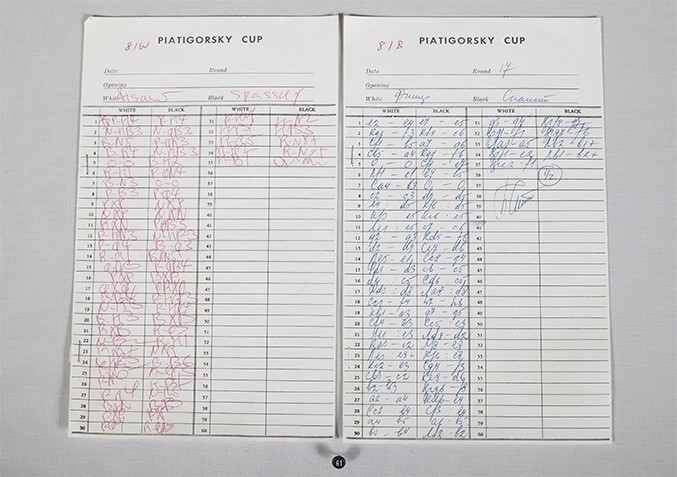
Score Sheets for Bobby Fischer—Boris Spassky Game, Round 17
1966
Manuscript
Collection of the World Chess Hall of Fame
Photo © Michael DeFilippo
Surprisingly, despite being two of the best players in the world from 1958 onwards, Fischer and Spassky had met over the board only once prior to the 1966 Piatigorsky Cup. Their first game in the Cup was played in round eight, with Boris tied for first and Bobby reeling after consecutive losses to Bent Larsen and Miguel Najdorf. It was an epic encounter in which Spassky gave a classic demonstration of the superiority of bishop over knight in the endgame.
During their second game the circumstances had changed greatly. Spassky was still in the lead, but Fischer had staged a strong comeback. Fischer had the advantage of the white pieces in what was likely to prove to be the decisive game of the tournament. Spassky had slowed down after a strong start and had only won a single game in rounds nine through sixteen. All momentum pointed in Fischer’s direction, but Spassky was equal to the challenge. His decision to use the Marshall Gambit opening to counter Fischer’s Ruy Lopez opening was an inspired choice, and it worked like a charm, as it did the previous year in the Candidates Final against Mikhail Tal. Black’s initiative fully compensated for the pawn deficit, and Bobby never got a hint of an advantage.
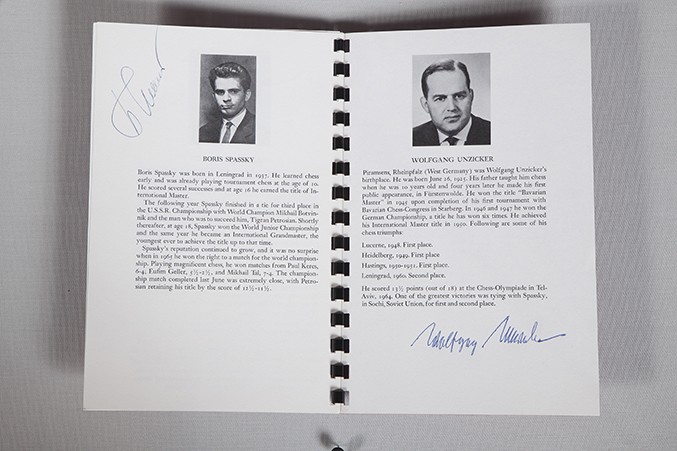
Inscribed 1966 Piatigorsky Cup Tournament Program
1966
Pamphlet
Collection of the World Chess Hall of Fame
Photo © Michael DeFilippo
The participants in the 1966 Piatigorsky Cup tournament signed their biography pages in this program for Jacqueline. They perhaps did this as a gesture of gratitude to her for organizing the competition. Signed programs were popular souvenirs among tournament attendees.
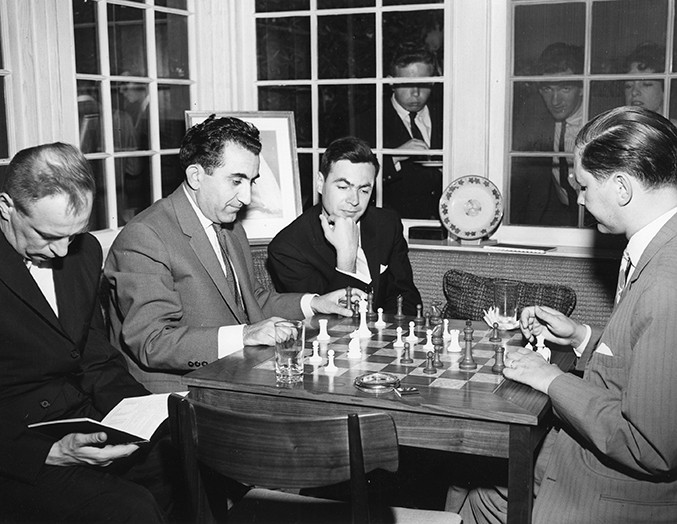
Otto Rothschild
Tigran Petrosian Analyzing with Paul Keres as Oscar Panno Watches
1963
Photograph
Collection of the World Chess Hall of Fame
Surrounded by interested onlookers, Tigran Petrosian and Paul Keres share thoughts about critical moments in their earlier game. Known as the postmortem, this is one of the most beloved institutions in chess. The traditional postgame analysis was especially important in the days before the rise of strong computer engines as it allowed the players to gain a deeper insight into a game’s events.
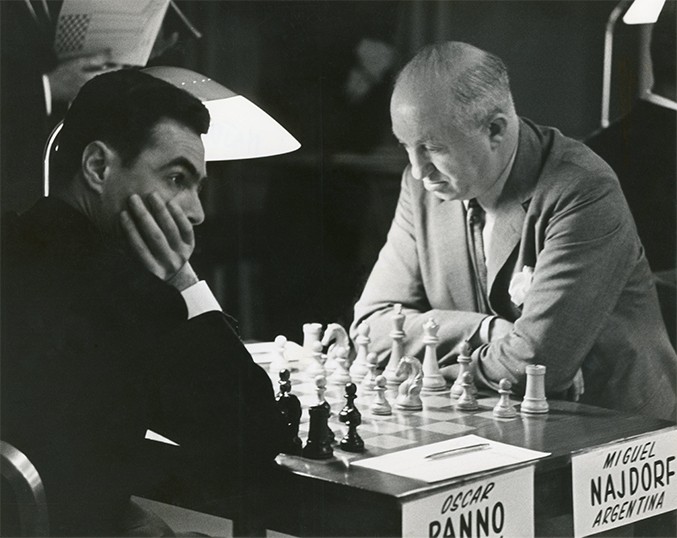
Otto Rothschild
Oscar Panno and Miguel Najdorf in the Opening Stage of their First Round Game
1963
Photograph
Collection of the World Chess Hall of Fame
Oscar Panno looks away from the board while Miguel Najdorf analyzes the game. Najdorf scored the first victory of the 1963 tournament with his win over Panno. Najdorf, the oldest competitor, ended the tournament in a tie for third with Fridrik Olafsson, while Panno tied for last place with Pal Benko. Najdorf said that the event was, “one of the most beautifully-organized tournaments of all time.” He further stated that, “The Piatigorskys and Mr. Kashdan have the sincerest thanks of every player.”
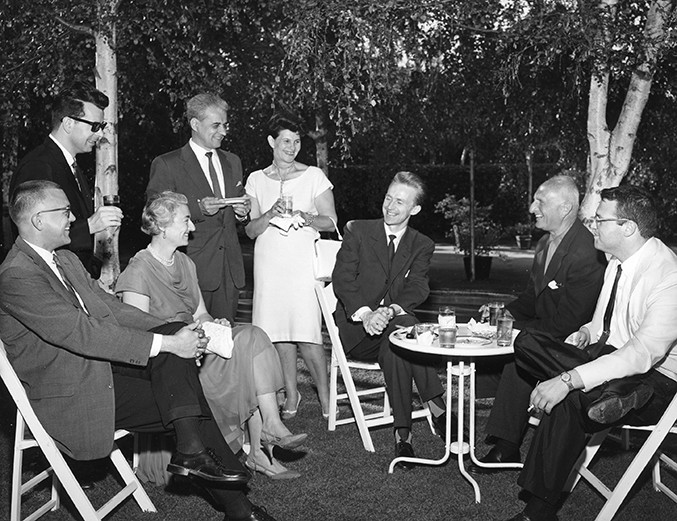
Otto Rothschild
Cocktail Party with 1963 Piatigorsky Cup Participants at the Home of Jacqueline and Gregor Piatigorsky
1963
Photograph
Collection of the World Chess Hall of Fame
Among the group of happy celebrants pictured are, on the far left, William Addison (tournament commentator), Pal Benko (tournament participant), and Jacqueline Piatigorsky. Sitting and smiling in the center of the group is tournament participant Fridrik Olafsson of Iceland. At this party, a group of chess aficionados from the Los Angeles area gave Jacqueline a trophy in appreciation of her organization of the tournament.
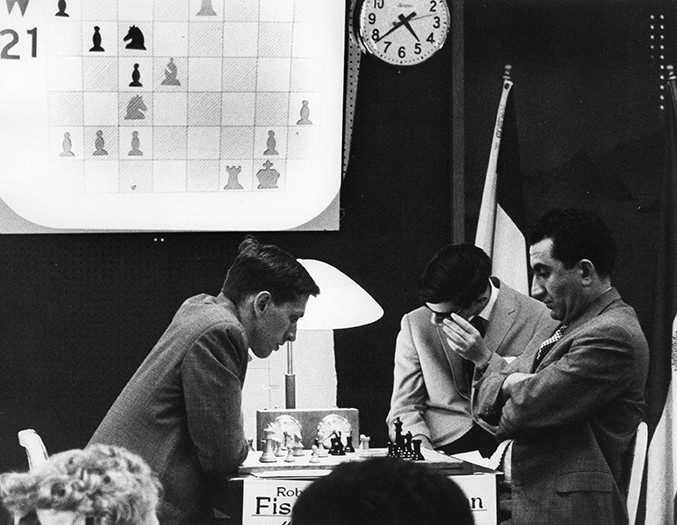
Art Zeller
Bobby Fischer Competes against Tigran Petrosian in the Piatigorsky Cup Tournament
1966
Photograph
Collection of the World Chess Hall of Fame
The reigning and future World Champions Tigran Petrosian and Bobby Fischer battled to a draw in round nine of the 1966 tournament. Fischer is analyzing the position after Petrosian’s 20...Nc5, while Petrosian folds his arms and reclines in his chair. The clock above the wall boy shows Petrosian’s elapsed time.
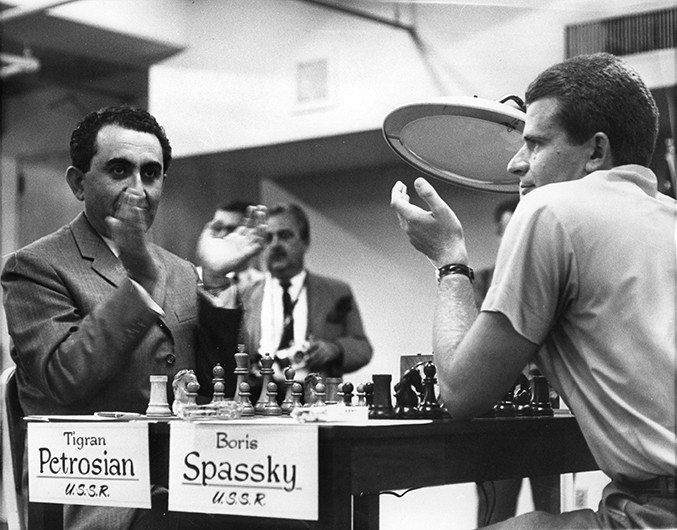
Art Zeller
Tigran Petrosian and Boris Spassky Applaud the Opening of the Tournament
1966
Photograph
Collection of the World Chess Hall of Fame
Tigran Petrosian and Boris Spassky clap before the opening round of the tournament. International Master Herman Steiner designed the chess set in front of them, which features unique knights. Players used sets of this style in both the 1963 and 1966 Piatigorsky Cup tournaments. The two rivals had played a 24-game world championship match, which ended a little over a month before the start of the Piatigorsky Cup with the former prevailing 12 ½ - 11 ½.
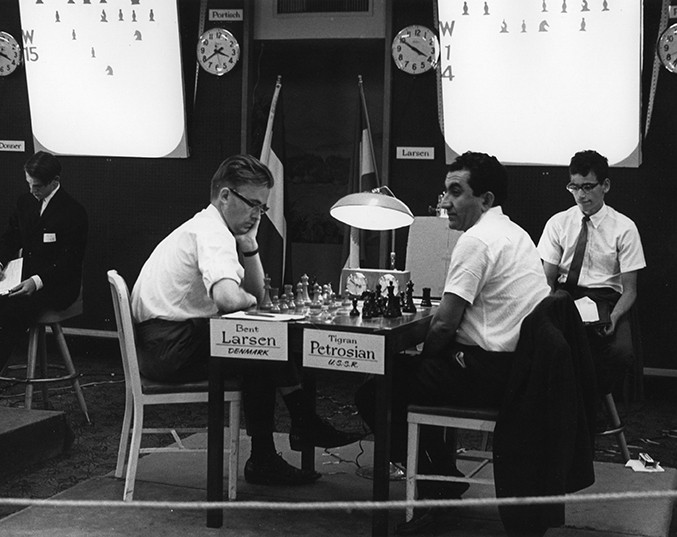
Art Zeller
Bent Larsen and Tigran Petrosian Compete in the 1966 Piatigorsky Cup Tournament
1966
Photograph
Collection of the World Chess Hall of Fame
Bent Larsen appears contemplative at the beginning of a game that would eventually become known as a classic. The Dane, Larsen, defeated reigning World Chess Champion Petrosian with a stunning Queen sacrifice (25. Qxg6!). Behind the players a projection of the game can be seen, a system of displaying games designed by Jacqueline Piatigorsky herself. This method of showing the games was more efficient than the system of using wallboards with wall boys moving the pieces, which had been used in the 1963 tournament.
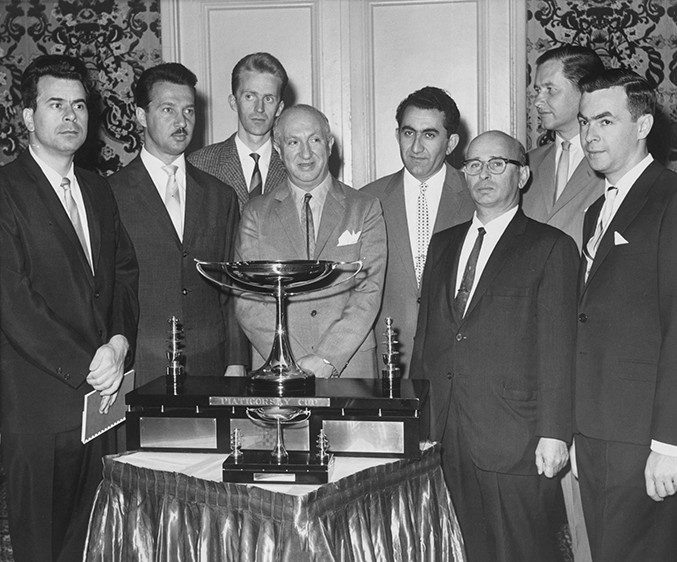
Photographer unknown
Participants in the 1963 Piatigorsky Cup Tournament
1963
Photograph
Collection of the World Chess Hall of Fame
The eight participants in the 1963 Piatigorsky Cup tournament gather for a photo behind the trophy. From left to right, they are: Pal Benko, Svetozar Gligoric, Fridrik Olafsson, Miguel Najdorf, Tigran Petrosian, Samuel Reshevsky, Paul Keres, and Oscar Panno. Though a smaller version of the trophy (visible in the photo) was manufactured for the tournament, it may not have been awarded since there were two co-winners.
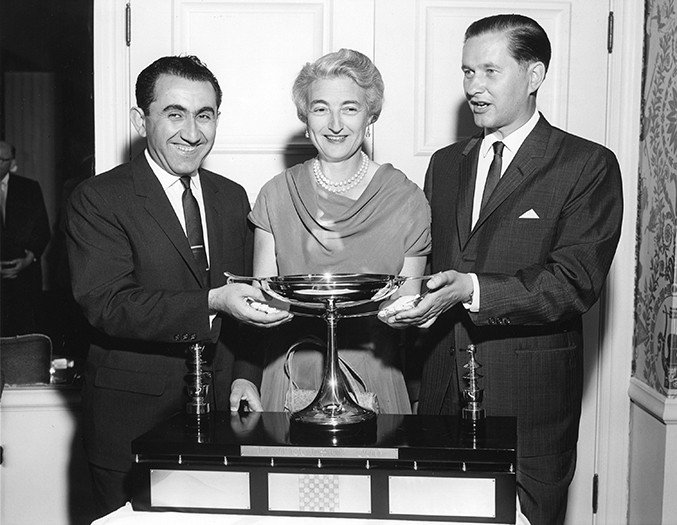
Otto Rothschild
Jacqueline Piatigorsky with the Winners of the 1963 Piatigorsky Cup Tournament, Tigran Petrosian and Paul Keres
1963
Photograph
Collection of the World Chess Hall of Fame
The reflective quality of the Piatigorsky Cup’s surface is highlighted in this photo, which depicts the happy victors of the tournament with Jacqueline Piatigorsky. Paul Keres and Tigran Petrosian split the prize for first. Keres chose to receive a car, a Rambler Classic 660, instead of the cash prize of $3000, an amount which would equal $23,000 today.
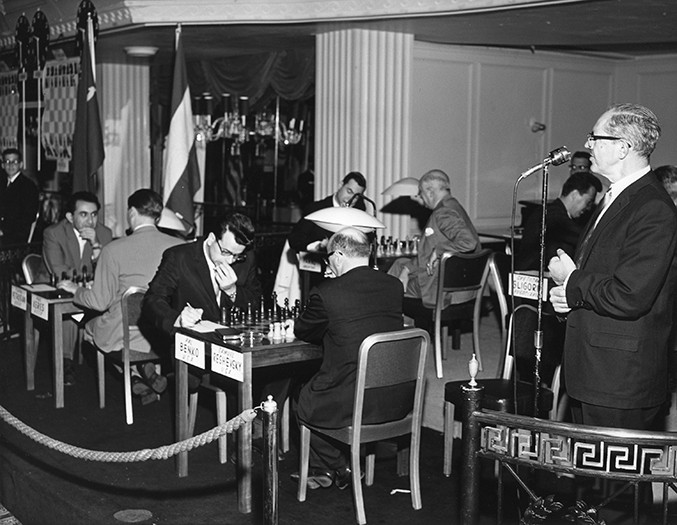
Otto Rothschild
Tournament Director Isaac Kashdan Addresses the Players before the First Round of the Piatigorsky Cup Tournament
1963
Photograph
Collection of the World Chess Hall of Fame
Isaac Kashdan, the director of both the 1963 and 1966 Piatigorsky Cups, delivers a speech before the beginning of the 1963 event. In the background, a wall board can be seen which tracked the action of the games for the audience, who gathered on the other side of the ropes.
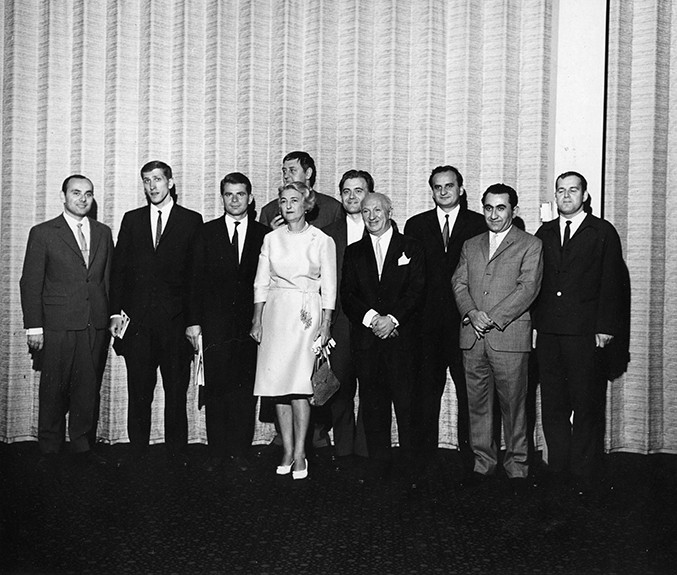
Phil Bath
Participants in the 1966 Piatigorsky Cup Tournament
1966
Photograph
Collection of the World Chess Hall of Fame
The players in the 1966 Piatigorsky Cup surround Jacqueline Piatigorsky, who is standing at the center in a white dress. Piatigorsky had difficulties securing the participation of the two Soviet players, Boris Spassky and Tigran Petrosian, so she invited more competitors from other nations. Ultimately, they were able to participate, and so she increased the field of participants from eight to ten.
Pictured from left to right: Lajos Portisch, Bobby Fischer, Boris Spassky, Jan Hein Donner (back), Jacqueline Piatigorsky, Bent Larsen, Miguel Najdorf, Boris Ivkov, Tigran Petrosian, and Wolfgang Unzicker. Samuel Reshevsky is missing from this photograph.
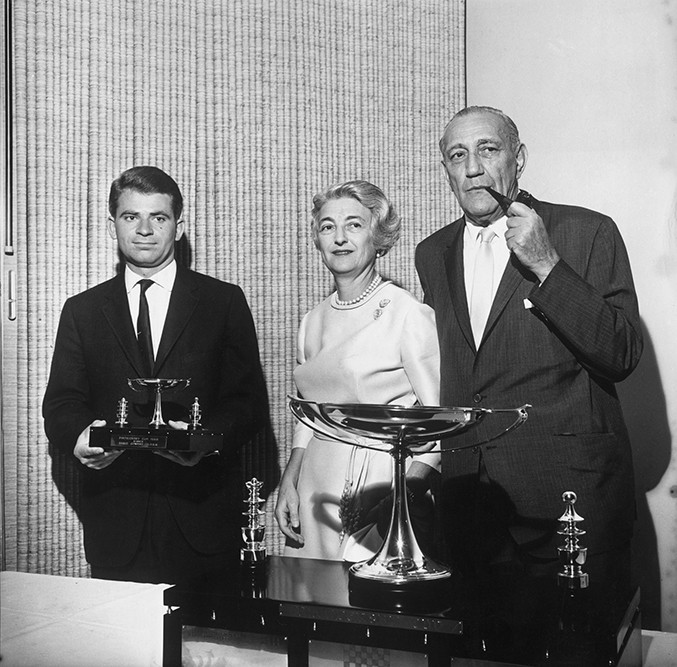
Phil Bath
Boris Spassky, Jacqueline Piatigorsky, and Gregor Piatigorsky with the Piatigorsky Cup Trophy
1966
Photograph
Collection of the World Chess Hall of Fame
Boris Spassky, victor of the 1966 Piatigorsky Cup, poses with Jacqueline and Gregor Piatigorsky. Spassky is holding the smaller presentation trophy that he received for winning the event. The perpetual trophy, which would soon be engraved with his name, is on the table before the tournament sponsors. Phil Bath, who photographed this scene, covered the 1966 Piatigorsky Cup Tournament for Sports Illustrated magazine.
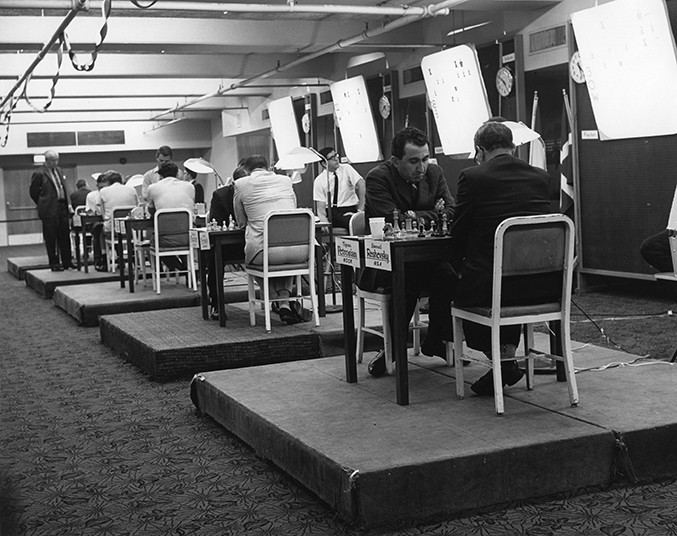
Art Zeller
Competitors Playing in the 1966 Piatigorsky Cup Tournament
1966
Photograph
Collection of the World Chess Hall of Fame
This photo was taken during round two of the tournament, which was played at the Miramar Hotel in Santa Monica, California, one block from the Pacific Ocean. Tigran Petrosian and Samuel Reshevsky are in the foreground. Jacqueline Piatigorsky believed that holding the tournaments in a more upscale venue would add prestige to the sport. Her meticulous attention to detail included overseeing tasks both large and small. She vacuumed the floors of the tournament room after the hotel staff neglected to complete the task, a story that was recounted in many articles about the tournament.
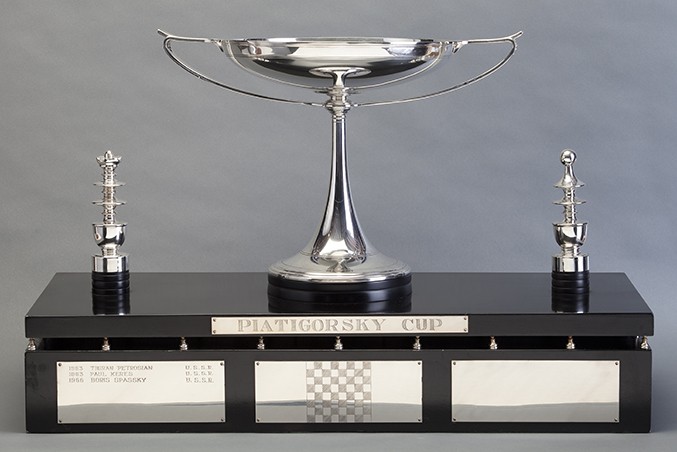
Piatigorsky Cup Trophy
1963
Manufacturer of Cup: Tiffany & Co.
Silver and wood
Photo © Michael DeFilippo
The well-known jewelry and silverware manufacturer Tiffany & Co. manufactured the gleaming sterling silver two-handled vessel, or “love cup” at the center the Piatigorsky Cup trophy. Tiffany & Co. produced the Nassau Cup, a trophy for a sailing competition, in the same pattern. The Cup is flanked by two silver-plated Régence-style chess pieces, a king and a queen. Régence-style chess sets originated in France, where Jacqueline had been born. This trophy was intended for display during the competition. A reduced-size version of the Cup was presented to Boris Spassky after his victory in the 1966 competition, and can be seen in some of the photos included in this exhibition.
As the Piatigorsky Cup was originally planned to be held every two or three years, the front of the trophy has space for the names of future winners. However, Jacqueline stopped organizing the competitions after the 1966 event due to the immense amount of effort required to gain the participation of some of the players.
All artifacts are collection of the World Chess Hall of Fame, gift of the Family of Jacqueline Piatigorsky, unless otherwise stated.

